Step out of the shadows
A little self-trust is all it takes to let yourself shine

Burnt toast theory
Could life’s little inconveniences be part of a bigger plan?
DEVOTED TO MENTAL HEALTH & WELLBEING + ISSUE 86 £5.99 ALL WORK NO PLAY?
Why we all need a third place SPOTLIGHT How the world of sport
stepping up to tackle the climate crisis
Romantic revelations from your favourite reality TV A love-hate relationship
is
A LEAGUE OF THEIR OWN

“Courage is the power to let go of the familiar RAYMOND LINDQUIST
Photograph | Andrea Piacquadio
Weathering the storm
Have you ever felt like you had a lucky escape? The frantic extra 10 minutes searching for your keys, or the irritation at getting caught by endless red lights delaying your journey, putting you in a bad mood, only for this to evaporate upon seeing an accident you might have been in were you on schedule?
It’s the feeling that minor inconveniences that hold up your day, or change your course, are actually redirections from the universe, guiding you away from the path of danger, or steering you towards something that’s meant for you.
That’s the idea behind burnt toast theory, anyway (p12). And it can be a helpful tool to reframe your outlook on life’s minor frustrations – but blind optimism isn’t the order of the day here. Sticking a plaster over a broken arm won’t do a lot of good. Likewise, trying to sugarcoat the toughest parts of life won’t make them any easier to swallow.
There are times when life just seems too unfair, too cruel to imagine a justifiable plot diversion. And in those moments, it’s not about finding a theoretical silver lining, or an answer that explains away the pain. All you can do is be there for one another.
Sometimes you have to sit in those dark moments, and know that one day, even if you can’t imagine when or how, a glimmer of light will break through once again. In the meantime, having someone by your side makes the darkness a little less scary.
Our article on p21 explores this power of social connections, by highlighting our need for ‘third places’. Could finding yours – a place beyond work and home to connect with others – be a lifeline in challenging moments?
It’s also vital to realise that you don’t need to justify your wants or needs for the approval of others. So we’re uncovering ‘worthsplaining’ (p61), which many of us may be guilty of, without even realising.

Bob Marley once said: “You never know how strong you are until being strong is your only choice.”
If this speaks to you right know, just know that strength isn’t about having a stiff upper lip. True strength of character is in being vulnerable, knowing when it’s OK to lean on others for support, and finding your own way through tough times, however you need to. No explanation required.
Just know that you don’t have to journey alone.
Happy reading,
REBECCA THAIR | EDITOR-IN-CHIEF

At Happiful, inclusivity, representation, and creating a happier, healthier society are at the forefront of our mission. To find out more about our social and environmental pledges, visit happiful.com/pledges
W | happiful.com
F | happifulhq
X | @happifulhq
I | @happiful_magazine
Rebecca portrait | Studio Rouge


Try this at home 32 Answer your inner critic 50 Is it toxic positivity? 51 Picture riddle me this 69 Reminders for tough times 73 Unusual ways to de-stress 21 25 Relationships 14 What is stonewalling? Do you feel like you’re facing a brick wall during arguments? 25 Late bloomer How compulsory heterosexuality can impact people’s self-discovery 33 Parenting tweens Navigating five key challenges that come with this stage of life 46 Getting real Michelle Elman on the relationship lessons we can take from reality TV 7 Good news 11 The wellbeing wrap 41 Our book picks 70 Try these 10 things Culture This is your space 12 What is burnt toast theory? Discover the trend encouraging you to reframe life’s inconveniences 21 Discover your ‘third place’ Why your life shouldn’t just revolve around work and home 38 Living in someone’s shadow? Five tips for finding your spotlight 43 Feeling good v mania How can you tell the difference? 52 The power of mircobreaks Could a purposeful pause be the key to productivity? 75 Picking up a pattern? What is ‘enhanced pattern recognition’ and how is it linked to ADHD?


Wellbeing
Five life-changing concepts
Handling AI anxiety
Our expert offers advice for anxiety around rapidly evolving technology
Friendship and ASD Ways to be there for an autistic friend
The manifestation mystery
What’s it all about and how does it work? Our expert columnist explains
What is worthsplaining?
Food
& health 28 How to quit a sugar addiction 58 Start the day right
Try this twist on classic beans on toast 66 Food myths, debunked
What’s the reality of food’s connection to mood?


Escape to create
Reclaiming your time
it possible to balance work, parenthood, and you-time?
Go your own way
the benefits of solo travel
The ultimate daily habit
the power of meditation
Journaling for tough times

* Expert review
Every issue of Happiful is reviewed by an accredited counsellor, to ensure we deliver the highest quality content while handling topics sensitively.
The need to communicate effectively in relationships is of prime importance. Unsurprisingly, it appears that most issues in relationships stem from poor communication. How we communicate with others is equal to how we communicate with ourselves, and observing this can provide insight into our internal world. Head over to p14 to identify how to overcome barriers to communication in relationships. The time you invest in managing communication is invaluable, as it has great potential to enrich your experience and theirs, leading to healthier and happier relationships.

17
30
48
56
61
18
36
How
64
78
80
83
Four wins for the planet
to find space to be creative
Is
Unlock
Discover
Positive pointers
43 78 30 38 Rav is a counsellor and psychotherapist with more than 10 years' experience. BA MA MBACP (Accred) RAV SEKHON 64
Happiful Community
Meet the team of experts providing information, guidance, and insight throughout this issue

NIKITA THAKRAR NLP
Nikita is a multifaceted teacher, mentor, and coach, supporting people to find their life purpose.

GEORGINA STURMER
BA (Hons) MBACP
Georgina is an integrative counsellor helping clients create a more confident life.

LIR COWMAN
BA MBA ICF ACC
Lir is a personal and professional coach and a business improvement consultant.

FRANCES TRUSSELL
MA PGDIP CL.HYP MPMT
Frances is an author, therapist and mindfulness meditation teacher.


DR REBECCA O’SULLIVAN
BSc DCoP
Rebecca is a psychologist specialising in complex trauma, and working in a holistic manner.

EMILY KNIVETT
BA (Hons) MBACP
Emily is an integrative therapist who is neurodiversity-affirming, and based in Surbiton and online.

HELEN ROBINSON
Dip ACC
Helen is a coach who helps people make the most out of their life by finding their purpose.

XUXA MILROSE
mBANT rCNHC mANP
Xuxa is a nutritional therapist with particular interest in the brain-gut connection.
Our team
EDITORIAL
Rebecca Thair | Editor-in-Chief
Kathryn Wheeler | Features Editor
Lauren Bromley-Bird | Editorial Assistant
Bonnie Evie Gifford, Kat Nicholls | Senior Writers
Becky Banham | Content & Marketing Officer
Michelle Elman, Nikita Thakrar | Columnists
Ellen Lees | Head of Content
Keith Howitt | Sub-Editor
Rav Sekhon | Expert Advisor
ART & DESIGN
Amy-Jean Burns | Head of Product & Marketing
Charlotte Noel | Creative Lead
Rosan Magar | Illustrator
COMMUNICATIONS
Alice Greedus | PR Manager
Emily Whitton | Marketing Coordinator
CONTRIBUTORS
Fiona Fletcher Reid, Victoria Stokes, Lir Cowman, Kai Conibear, Lydia Wilkins, Xuxa Milrose, Emma Victoria Stokes, Nicki Bannerman, Lara Green, Tanith Carey
SPECIAL THANKS
Emily Knivett, Dr Rebecca O’Sullivan, Georgina Sturmer, Frances Trussell, Helen Robinson
MANAGEMENT
Aimi Maunders | Director & Co-Founder
Emma Hursey | Director & Co-Founder
Paul Maunders | Director & Co-Founder
SUBSCRIPTIONS
For new orders and back orders, visit shop.happiful.com, or call Newsstand on +44 (0)1227 277 248 or email subenquiries@newsstand.co.uk
CONTACT
Happiful, c/o Memiah, Building B, Riverside Way, Camberley, Surrey, GU15 3YL Email us at hello@happiful.com
HAPPIFUL FAMILY
Helping you find the help you need. Counselling Directory, Life Coach Directory, Hypnotherapy Directory, Nutritionist Resource, Therapy Directory
Are you a wellbeing expert with valuable insight to share? Happiful professional membership includes opportunities to be featured in our award-winning magazine. Discover how to join by emailing us at professionals@happiful.com

CBP006075
Join the Happiful Expert Panel
The Uplift
ANIMALS
Retirement village introduces ‘emotional support chickens’
A retirement village in Lancashire is spreading its wings and reaching out into new territory by welcoming a flock of chickens as part of its bid to offer a ‘person-centred approach to care’. The Lodge care home, part of Buckshaw Retirement Village near Chorley, was offered the birds by local primary school teacher Claire Harrison, following a recent chicken hatching programme at her school, St Paul’s CoE Primary School.
It’s hoped that the chickens will bring residents a number of benefits, from fostering a sense of community to reducing stress and anxiety, as well as in encouraging mental engagement, physical activity, and nostalgia.
“Caring and spending time with the chickens will be a beautiful reminder of the past for many who recall their own families keeping chickens,” says Hayley Rowson de Vares, manager at Buckshaw Retirement Village. “This project
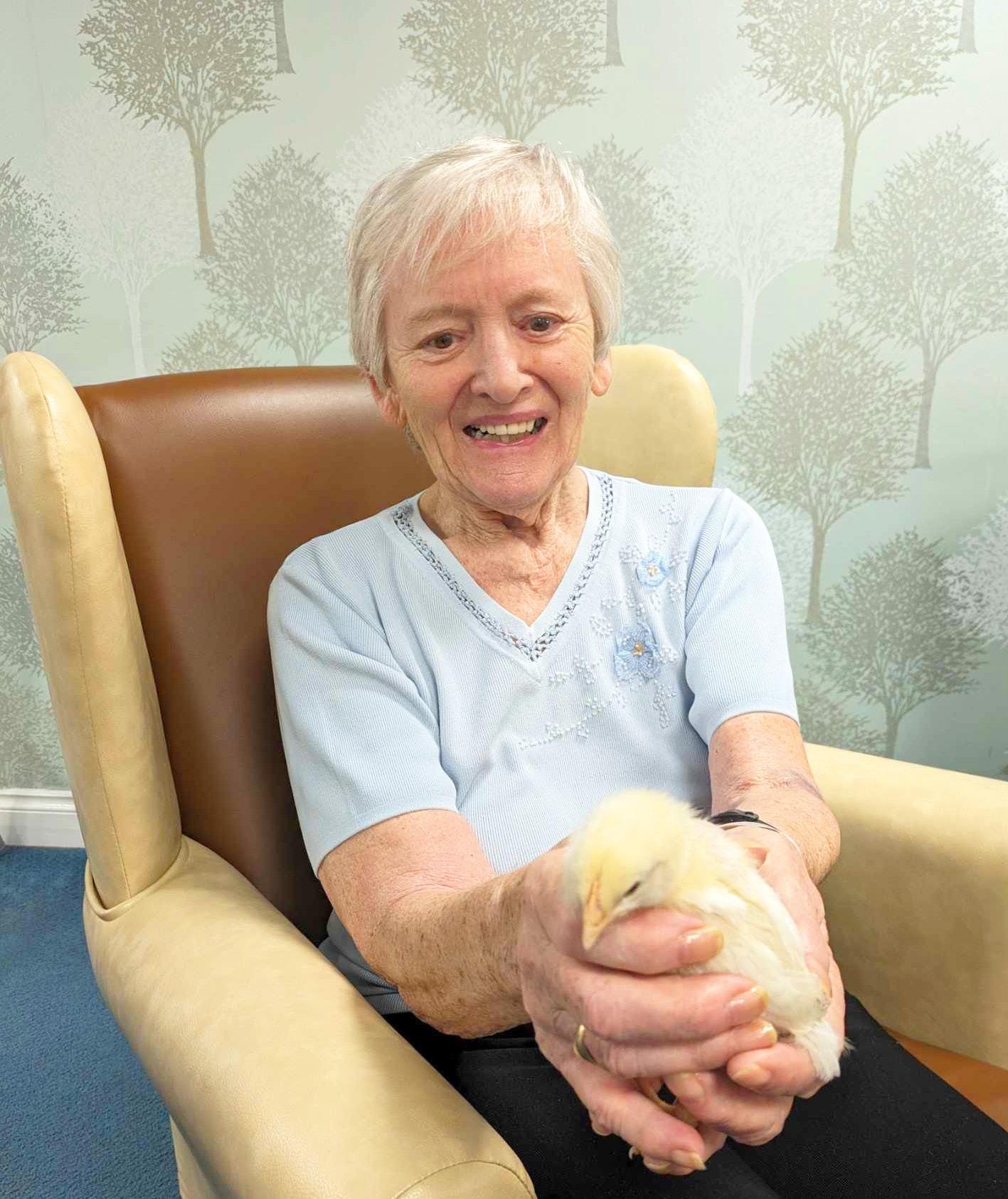
is not just about adding life to our garden, but also about reconnecting our residents with their heritage, and providing them with emotional support through the joy and serenity that comes with caring for animals.
“One of our care workers is leading a lovely chicken-naming project and organising a coop opening party, inviting everyone – residents, their relatives and
staff – to embrace the theme by dressing as ‘funky chickens’. This event promises to be a memorable celebration, marking the beginning of a new chapter in our community’s life.” Finding creative ways to bring joy into our daily lives is a surefire way to boost wellbeing, and this latest offering sounds like a squawker.
Writing | Kathryn Wheeler
happiful.com | Issue 86 | 7
Photography | HICA Group

8 | Issue 86 | happiful.com
Cabmen’s Shelter, Northumberland Avenue at the junction with Embankment Place, London © Historic England Archive

Stepping back in time can boost our wellbeing
Could living near, and preserving, local heritage sites have an impact on our wellbeing? According to new research from Historic England, that answer is a resounding ‘yes’.
In its report, Historic England sets out to examine the relationship between heritage density and life satisfaction. What they saw was that – similarly to the impact of green spaces – the presence of nearby historic places benefits residents’ quality of life, whether or not they participate in heritage activities.
It’s estimated that the overall ‘wellbeing value’ for people’s day-to-day encounters with their heritage is worth £29 billion every year in England. Using the guidance from the Treasury on measuring and quantifying the effects of policies on people’s lives in economic terms, the report also shared that, on average, your life satisfaction improves to the value of £515 a year simply from living near to heritage sites.
“People often experience emotional connections with their local heritage, yet the link between heritage and wellbeing is frequently overlooked in economics,” says Adala Leeson, head of social and economic research at Historic England.
“This innovative research uses economic techniques to demonstrate that heritage is not just nice to have; it has significant, measurable impacts on our overall wellbeing.”
Interested in discovering what your local area has to offer? Head to historicengland. org.uk and search for listed buildings, battlefields, monuments, gardens, shipwrecks, and more, near you.
Writing | Kathryn Wheeler
happiful.com | Issue 86 | 9
TOURISM
Tristan speaks with his ‘adopted’ grandparent David.
CHARITY
Father and son both ‘adopt’ a grandparent
Though loneliness in older communities is becoming increasingly prevalent, there are many charities doing remarkable things to support elderly people. One such organisation that deserves every ounce of recognition is Adopt a Grandparent.
The charity pairs socially isolated older individuals from UK care homes with volunteers worldwide, to help foster intergenerational, long-lasting connections. The aim is to alleviate feelings of loneliness through companionship.
According to the charity’s website, 200,000 older people hadn’t had a conversation with a friend or
BOOKS
relative in more than a month, but this innovative project is a solution that could help.
One father and son who enrolled in the scheme are 15-year-old Tristan Sue and his 48-year-old father, Jeff. Tristan was paired with 78-year-old David Abel because of their similar interests in sports, and their regular calls gave David an opportunity to laugh and smile, despite having advanced dementia. Meanwhile, Jeff, who had little contact with his own grandparents, was matched with 74-year-old Margaret Smith, which yielded conversations that were meaningful to both of them.
Jacqueline Wilson revisits beloved series in new novel for adults
In news that will delight many childhood readers, Dame
Jacqueline Wilson has announced her new book, Think Again, will revisit the characters of her Girls series nearly 30 years after the books were first published.
Set to be released in September 2024, her new book returns to life-long best friends Ellie, Magda, and Nadine as they navigate the highs and lows of adulthood, self-discovery, and the need to push themselves beyond
their comfort zones to achieve fulfilment.
Speaking about her new book in a video on social platform X, Jacqueline Wilson said: “Still today, young women come up to me in the street to tell me how much those books meant to them, and they often ask me what happened to those characters. My new novel, Think Again, will answer those questions.”
Revisiting beloved characters and series from your childhood can provide the perfect opportunity for

Speaking highly of the scheme, the founder of Adopt a Grandparent, Shaleeza Hasham, says: “The calls they’ve already had have been a great success, bringing both parties joy and companionship, and that’s what the charity is all about. I personally look forward to seeing the relationships develop with every future call.”
Inspired to make a difference? Visit adoptagrandparent.org.uk
Writing | Lauren Bromley-Bird
experiencing a little nostalgia. Creating not only a sense of support and reconnection, nostalgia can help us to feel more optimistic and inspired, boost our sense of self-esteem, and can even help us to feel more purposeful and youthful. Add in the wellbeing benefits of reading, and you have a recipe for a restorative and comforting outlet for life’s little stresses. So, will Think Again be making your to-read list?
Writing | Bonnie Evie Gifford
10 | Issue 86 | happiful.com
Finland has been named the world’s happiest country for the seventh year in a row
The wellbeing wrap
DRIVING CHANGE
The UK government has announced £4.65 million for the Accessible Information Grant, which looks to improve public transport by providing small business operators with funds to enhance services to better cater to disabled passengers. The aim is to ensure everyone has suitable transport links, and is able to complete journeys with confidence and dignity.
Open your mind
Marine scientists have discovered potentially 100 new species of sea creatures off the coast of New Zealand
The Early Cancer Institute in Cambridge, dedicated to early detection, has been given £11 million by an anonymous donor
Nicknamed the ‘Hardest Geezer’, Brit Russell Cook ran the length of Africa in 352 days, and raised £950,000+ for charity
Rising to the occasion
Lawmakers in Florida, USA, have passed a bill to ban all intentional balloon releases, and charge anyone who breaks this rule. As balloons are the number one cause of marine debris-related death for seabirds, with scientists from the Ocean Conservancy revealing that one in three seabirds that consume a single piece of a balloon will die, this is a change to be celebrated, that will hopefully save the lives of many marine creatures.
In a bid to provide more free, easily accessible samples to students, teachers, scientists – and, of course, the general public – the openVertebrate project was recently completed. Taking five years, and using CT scans to display the detailed anatomy information of 13,000 amphibians, fish, reptiles, and mammals, the project has created a free online museum that anyone searching for more knowledge on the inner workings of creatures can find, and learn from.
Working it out
Sedentary lifestyles aren’t good for us – we all know that, but, unfortunately, a lot of us can’t change too much about it if our day job involves us sitting at a desk. But, there is some good news with a recent study published in JAMA Network Open, that looked at more than 480,000 participants over 13 years, and found that just 15 to 30 minutes of physical activity a day could be enough to counter the side-effects of sitting for such prolonged periods.
Researchers in Sweden have developed a new way to identify high risk sepsis patients, likely to have complications, utilising innovative artificial intelligence to screen blood tests.
Arizona, in the USA, is undertaking steps to abolish medical debt in the state, which is set to provide relief to nearly a million residents. Local authorities partnered with non-profit RIP Medical Debt, with the value of the wholesale relief estimated to be worth $2 billion, going towards the spiralling medical bills for many of the state’s residents.
You’ve got a friend in me
For anyone who’s had a dog, you’ll already be familiar with the wealth of wellbeing benefits your four-legged friend can offer, but a new study suggests this can go even further for autistic kids. The research, published in Frontiers in Psychology, found that having a service dog significantly improved the sleep quality in children on the autism spectrum, after studying the habits and lifestyle of 75 families.
THERE’S SOMETHING IN THE AIR...
When asked what your favourite smell is, a lot of people reflect on that earthy, post-rain aroma (petrichor). But did you know some people have the ability to sniff out when it’s about to rain? IFLScience says that some people can pick out the scent of an approaching storm thanks to the way strong winds push down ‘bubbles’ of the ozone, and their ability to recognise that unique scent!
WHY YOU SHOULD EAT YOUR GREENS
If you needed more convincing of the power of green veg, a new three-year study by Australia’s Heart Research Institute has compelling evidence. It found a natural chemical in broccoli can reduce the likelihood of having a stroke, thanks to it decreasing the formation of harmful blood clots.

What is burnt toast theory?
Is the latest concept going viral on TikTok just another craze, or could it help us embrace the positives behind life’s little inconveniences?
Writing | Bonnie Evie Gifford
What if everything happens for a reason?
It’s a theory that we’ve all heard more than once. And in many ways, burnt toast theory can be seen as a modern take on this classic idea.
Finding fame through the #TherapyTikTok side of social media, burnt toast theory centres around the idea that every little inconvenience we experience in our day-to-day lives happens for a bigger reason. But can burnt toast theory help us to foster a growth mindset, or can it risk encouraging positive toxicity?
What is burnt toast theory?
We’ve all been there. Say you accidentally burn your toast before leaving for work. According to burnt toast theory, this single, tiny inconvenience is enough to have a domino effect. Your morning is then pushed back by what, maybe three to five minutes? Perhaps that is enough time to leave the house a little bit later than usual, and to avoid getting in a car accident. Or it might mean you end up getting a later train, and avoid bumping into an ex who you’d really rather avoid. Or maybe you meet someone who you wouldn’t otherwise have bumped into,
resulting in a new friendship or a chance at romance.
Burnt toast theory suggests that little inconveniences are the universe’s way of saving us from bigger, more detrimental things – or pushing us in new directions we may have otherwise missed out on. Much like with the butterfly effect theory, the idea is that little changes have a big impact.
When we choose to view the world in a more positive light, we can help to reduce feelings of anxiety, and release our fears of being out of control of the world around us. It’s a little way of helping us accept life’s little events and mishaps that are outside of our control.
Why
is it so popular?
Do you ever feel like you are constantly on edge? Perhaps you find yourself overthinking day-to-day interactions, or worrying about each and every little detail. These can all be signs of hypervigilance, which can be caused when we feel high levels of stress, anxiety, or a need for perfection.
When we feel like things in our lives are outside of control, this can add to our sense of hypervigilance, leaving us feeling

overwhelmed. Being able to focus on the idea that everything happens for a reason can help some people to let go of their need to try to control things, helping them to break automatic negative reactions, thoughts and feelings, and instead reframe things more positively. But is it actually helpful to try to view every mistake as an opportunity for positivity? Or could we be doing ourselves a disservice by not acknowledging when things are tough?
Is it helpful?
While always looking for the bright side can be helpful for some people, it can also be seen as a form of toxic positivity. While maintaining a positive mindset can be beneficial, only allowing yourself to focus on positive thoughts can mean that you are denying yourself the chance to properly engage with challenging or difficult emotions, instead focusing on creating a false positive façade. By avoiding, suppressing, or rejecting all negative emotions and experiences, you may inadvertently dismiss the impact that they are having on you, downplay how much they are affecting you, or even end up refusing to acknowledge when you are struggling.
12 | Issue 86 | happiful.com

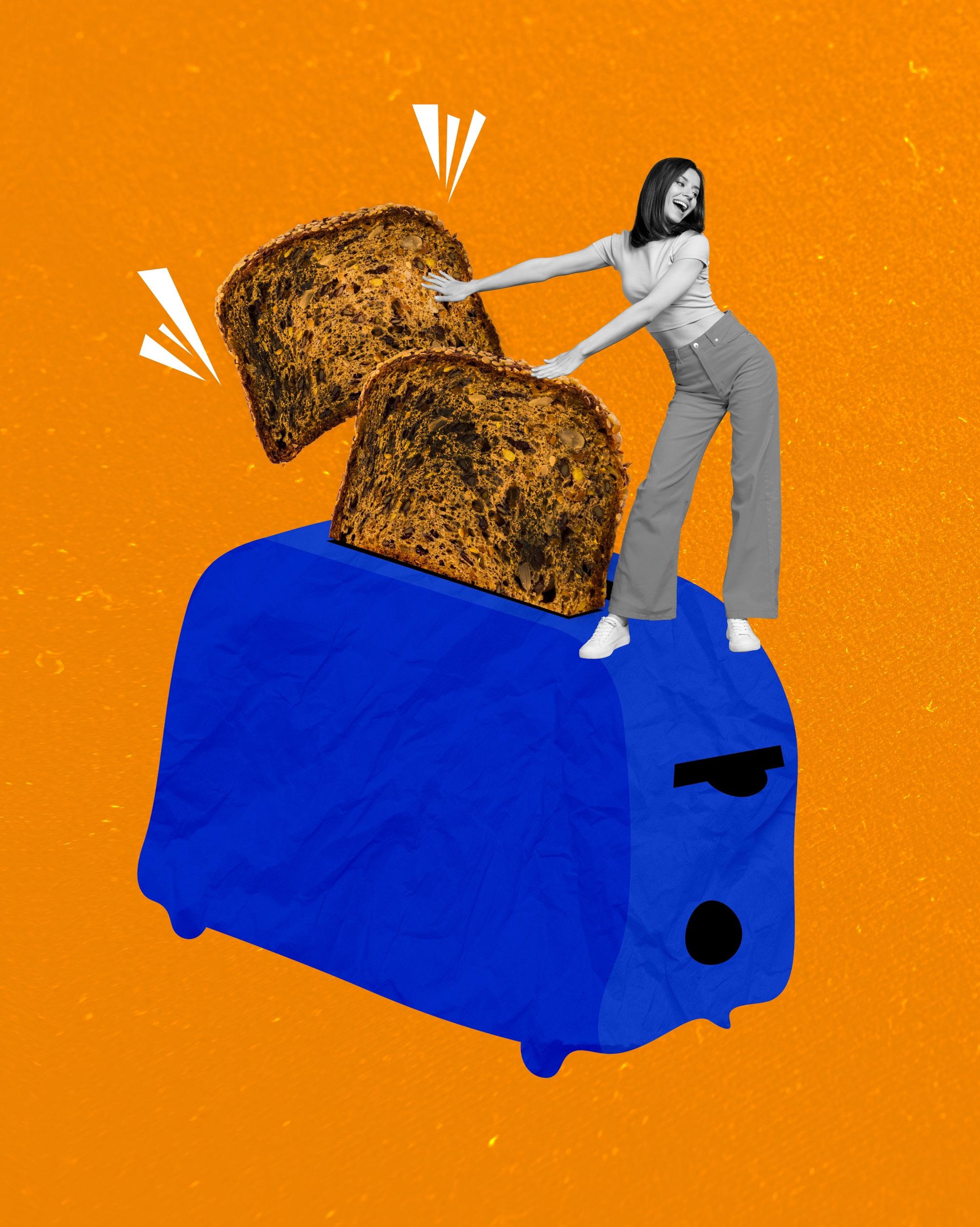
We cannot always be happy and optimistic. Trying to force ourselves to always see the positive side can make us feel worse about ourselves, may lead to pushing down negative feelings or experiences, and refusing to acknowledge or deal with them fully. Over time, this can almost create a cycle of shame and self-blame.
Acknowledging that bad things can and do happen is actually healthy. So, rather than all-ornothing thinking, try to find a balance that works for you.
Embracing positivity and developing a growth mindset
Instead of focusing purely on positive thinking, working towards developing and nurturing a growth mindset may be more helpful. A growth mindset –where you believe that your abilities can be developed through dedication and hard work, and that your talents are just a starting point – can help you rediscover your love of learning, as well as to become more confident, motivated, and resilient.
Embracing a growth mindset can help you to improve your relationships, how well you do at work, and how fulfilled you feel in life. It is also important to remember that any shift in how you think and approach things will take time and effort. Big, sustainable changes don’t happen overnight, or without self-reflection. Instead of trying to make yourself see the reason behind life’s little mistakes and uncontrollable events, try to:
• Take the time to acknowledge the little things that have gone right in your day.
• Surround yourself with positive influences and supportive people.
• Improve your self-care routines (the better you look after yourself, the more energy, motivation, and self-belief you will have).
• Avoid negative self-talk.
While burnt toast theory can help to provide a little mood boost when events out of your control get you down, it’s important to remind yourself: you don’t always have to look for life’s silver linings, or even the meaning behind a little burnt toast. Sometimes things happen, and they suck. But as long as we take time to acknowledge how these things make us feel, and recognise that we can’t always control everything around us, we can still work towards improving ourselves, and how we handle life’s unexpected challenges – and that’s what really matters.
happiful.com | Issue 86 | 13
your space
What is stonewalling?
If conflict erupts, communication breaks down, and you feel like you’re being ignored, then you might be dealing with stonewalling. But there is a way to have a connection breakthrough…
Writing | Fiona Fletcher Reid
Imagine you and your partner have agreed to be a little more frugal with your money to save for a new home. A few days later, your partner forks out a big chunk of cash on a designer watch and, understandably, you want to discuss how this purchase impacts your shared finances. When you approach the subject, they don’t respond. When you push them further, they leave the room, and refuse to talk to you for days. Something that could have been an open discussion has now become an elephant in the room, and to make things worse, you’re left feeling as though you caused the conflict by bringing it up in the first place. The relationship becomes fractured, and you feel isolated and unseen as a result of being denied the opportunity to have a helpful conversation. You’ve been stonewalled.
What is stonewalling?
When someone is stonewalling, they are choosing not to engage in a discussion. They may avoid eye contact, act too busy to
talk to you, give you the silent treatment, refuse to discuss their emotions, shut down, or leave the conversation entirely, without any effort to circle back once they’ve gathered their thoughts. And, look, taking time away to process in private is fine, but stonewalling is different because it shuts down any possibility of returning to the conversation.
Why do people stonewall
you?
People who stonewall aren’t always doing so intentionally. “Your partner may have learned this technique as a child as a method of peacekeeping, a defence mechanism, or copied it from a parent,” says Tini Riese, a neurodevelopmental specialist practitioner at Harley Row Clinic. They may feel so flooded with emotion during an argument that they don’t know how to respond, using avoidance as a way to retreat from uncomfortable conversations. Everyone has their own way of communicating, and yes, some people need time to privately process emotions
to allow them to articulate a response, but stonewalling has an undeniably destructive impact on relationships. When used deliberately, stonewalling can lean towards abuse, with the perpetrator claiming neutrality as a way to gaslight their partner and maintain power. Marriage researcher and psychologist John Gottman, PhD, found that 85% of those who stonewall are men, but women can also demonstrate the same behaviours. “Whatever the root cause of the issue,” says Tini, “it doesn’t negate the harm this can cause.”
The impact on relationships
Trying to avoid an argument might seem like a reasonable goal for someone in a relationship, but stonewalling can lead to more conflict in the long term. The lack of communication creates unnecessary distance between partners, which can create a disconnect, and a lack of emotional intimacy. When stonewalling becomes a common
14 | Issue 86 | happiful.com
Taking time away to process in private is fine, but stonewalling is different because it shuts down any possibility of returning to the conversation

behaviour, the list of unresolved issues accumulate, which creates a build-up of tension and makes communication more heated. Think of it this way: when you don’t get the chance to express your concern over the expensive designer watch purchase, it’s likely your partner will continue to behave in ways that contradict the money-saving plan you made together. Without ongoing communication, this is certain to lead to further conflict, and even more stonewalling.
As a result, the person on the receiving end will feel dismissed and confused. If the person stonewalling makes a habit of cutting off communication or fleeing the relationship, the person affected may act out of desperation to find a sense of safety, doing anything to restore the connection. This can lead to resentment, as they continually abandon their own needs to keep the peace. Without addressing the lack of communication, the stonewaller will never learn to regulate their emotions effectively.
How to handle being stonewalled
Don’t accept stonewalling as a behaviour that you simply have to put up with. It’s entirely reasonable to expect a partner to engage in difficult conversations with you. With that said, when you notice the stonewalling has started there is no sense in continuing to push them into talking. At that point, it’s important not to retaliate with aggressive language, or ‘give as good as you get’ by counteracting with the silent treatment. >>>
happiful.com | Issue 86 | 15 relationships

The solution lies in better communication, not forcing them to change.
Halt the discussion and give your partner space. If possible, agree on a specific date and time when you’ll both come together to pick up the conversation more calmly. Use this time away to take care of your own mental health, by practising self-soothing behaviours such as journaling, exercising, or spending time on your hobbies. The conversation will likely flow more easily and with fewer defensive behaviours if you both take steps to emotionally regulate. Be clear and let them know that you want to work through the conflict in partnership. Acknowledge that all relationships go through rough patches, but that you’re willing to do the work to find a resolution as a team.
Having a neurodiverse partner can add complexity to the situation. People with ADHD may struggle to talk when emotionally overwhelmed, and autistic partners may shut down completely. When they’re in a calm state, ask how they want you to handle difficult situations and come up with a plan of action together. For example, you might agree to discuss certain topics in a safe place, or use text/email instead of in person.
Improving communication
Tossing around accusations is a recipe for further conflict. Try initiating conversation using ‘I’ statements, like: “I felt hurt when you ignored my text messages.” Focus on reinforcing
the positive qualities you admire in your partner by saying things like: “You’re a really good listener, it makes me feel loved.”
Instead of insisting they act differently, make an effort to understand their point of view, and the deeper reasons behind their conflict avoidance. “Being clear and factual, giving them time to process the information, not putting pressure to answer immediately, and agreeing to alternative modes of communication, may reduce shutdowns and becoming defensive,” says Tini. “This advice could apply to a neurotypical partner as well, depending on their unique character.” If stonewalling continues, ask them to consider speaking to a trained therapist. The cause of stonewalling may be so deeply rooted that they may need support to find new ways to regulate their emotions. The safety of a therapist’s office will give you both space to explore your needs, and learn the best way to communicate. Above all, focus on finding solutions together, rather than winning an argument and, with mutual effort, you can heal the hurt and reconnect on a deeper level.
16 | Issue 86 | happiful.com
5 life-changing counselling concepts
There’s no one-size-fits-all when it comes to counselling. Discover five different concepts from popular modalities
Writing | Kathryn Wheeler
‘Counselling’ refers to general psychological support, and within it are a huge range of different approaches, often called ‘modes’. What works for one person may not for another, and so finding a counsellor who works in the way you need is imperative. Here, we’re offering up an overview of five key counselling concepts.
The answers could be in your childhood (psychodynamic theory)
Sometimes also called ‘psychoanalysis’, this counselling mode originates from the work of Austrian neurologist Sigmund Freud. A big name in psychology, Freud founded psychoanalysis, a clinical method for treating clients, which works with the idea that unconscious forces drive our behaviour. When working with a psychodynamic therapist, you may use tools such as ‘free association’, which is essentially just talking about whatever comes up without censoring or correcting, ‘dream analysis’, and ‘transference’ which refers to the redirection of emotions (usually
originating in childhood) on to the therapist.
Changing our actions leads to positive behaviour (behavioural therapy)
At the core of this approach is the belief that our behaviour is learned. The thinking comes from the research of Ivan Pavlov (yes, the one with the dog), who focused on the effects of building a learned response by introducing a stimulus. The goal of behavioural therapy is to modify behaviour by changing the external environment, and teaching the client new coping skills – for example, addressing phobias, unhealthy eating habits, or alcohol addiction, by fostering positive change.
We are all innately good people (humanistic approach)
The humanistic approach in psychology in part came about in reaction to what some thought were the limitations of behaviourist and psychodynamic theory. At its core, humanistic psychology is optimistic, and built on the premise that humans are
innately good, but that this can be disturbed during their process of growth. This mode takes into account the whole person, their uniqueness, and individuality.
There may not be one single solution (integrative counselling)
Combining the elements of different therapies together, integrative therapists believe that there is no single approach that would work for all clients in all situations. Instead, they propose that each person needs to be considered as a whole, and counselling techniques should be tailored to their particular needs. To do this, they may draw on many of the elements mentioned in the other modalities here.
Negative
feelings are a natural part of life (acceptance and commitment therapy)
Developed in the late 1980s in America, and growing in popularity ever since, acceptance and commitment therapy (ACT) works from the premise that negative thoughts and feelings are natural, and so does it not seek to directly change or stop unwanted problems and experiences, but rather to apply mindfulness strategies to help us accept the struggles we face.
Of course, this is just a handful of counselling approaches, with many of these examples also having multiple subcategories. To get a full picture, and connect with professionals specialising in different areas, visit the Counselling Directory.
wellbeing
happiful.com | Issue 86 | 17
A SPORTING CHANCE
Discover what the summer’s athletic exploits have planned for the planet, and ways that green thinking is getting a gold medal
Writing | Kathryn Wheeler

We’re in for a summer of sensational sport but, this year, organisers are thinking more carefully about the impact these events will have on our planet. Here, we’re rounding up four environmentally conscious events in play in 2024.
Euro 2024, June
Coming in as the third-largest sporting event worldwide, the organisers of the UEFA European Championships 2024 had an opportunity to make a huge difference by going green – and it
looks like they’re planning to do just that.
Set out in their Environmental, Social, and Governance strategy, they plan to tackle the environmental impact of the event across six areas: smart mobility (addressing the carbon impact of travel to events), carbon management, advocacy, energy consumption, water consumption, 4-R principle (reducing and reusing products), and waste management.
In practice, this strategy includes actions such as match ticket holders being entitled to
use public transport for 36 hours on match days, discounted longdistance train tickets, tournament carbon footprint measurements, reduction in floodlighting, use of renewable energy sources, grey water usage, limited packaging on products, and vegan and vegetarian options – to highlight just a selection of planned actions.
Wimbledon, July
Attracting more than 500,000 spectators each year, Wimbledon is a staple on the British sporting scene – and with it comes the
18 | Issue 86 | happiful.com
responsibility to consider the environmental impact. But it’s a responsibility the organisers take seriously, and which they believe is aligned with their values of ‘heritage, integrity, respect, and excellence’.
To do this, the organisers hope to reduce emissions from operations to ‘net zero’, become resource-efficient, and contribute to a net gain in biodiversity by 2030. For now, solar panels have been installed on clubhouses and maintenance buildings, lighting has been updated to LED lights around the estate, electric lawn mowers are used on the grounds, visitors can use water refill points, and menus are made up of seasonal food from across the British Isles.
But environmental sustainability also crosses over with social impact.
Approximately 55,000 tennis balls are used throughout the championships period but, fear not, used balls are sold daily, with the proceeds going to the Wimbledon Foundation, which donates £4 million a year to local, national, and international charities that champion opportunities for all.
Formula 1, British Grand Prix, July
The high-speed event is putting sustainability in the driving seat. By 2030, the goal is to achieve a net zero carbon footprint ‘from factory to flag’ which includes net
zero carbon powered race cars, low/zero carbon logistics and travel, 100% renewably powered offices, facilities, and factories, and credible offsets and CO2 sequestration programmes. By 2025, the hope is that every race qualifies as an ‘F1 sustainable spectacle’. This includes using sustainable materials, with all waste to be reused, recycled, or composted. Fans are offered incentives to travel to the events in ‘green’ ways, such as by using public transport or travelling by bike or by foot. What’s more, increasing biodiversity at circuits and facilities is on the agenda, the plan being that not only will this have a positive effect on the local environment, but it will also improve fans’ wellbeing by enhancing the space and improving air quality.
PARIS 2024 WILL USE 95% EXISTING OR TEMPORARY
INFRASTRUCTURE FOR THE GAMES
Olympic Games, Paris, August
Without a doubt the sporting event of the summer, all eyes will be on the Olympic Games in Paris, and so getting
sustainability right is of paramount importance.
To get things started, Paris 2024 will use 95% existing or temporary infrastructure for the Games. This falls under the ‘less’ concept for the event, which includes ‘fewer venues built, less equipment produced, less single-use plastics for food and drink, less carbon, and fewer resources used’. Along with ‘less’ comes ‘better’, which features better design of temporary infrastructure, better sourcing of energy supplies, better consumption and support for local businesses, and better adaptation to weather conditions.
But the commitment to sustainability doesn’t end with the Games. In 2025, the Athletes’ Village is set to be transformed into a neighbourhood where more than 12,000 people will live. Plus, pollution in the river Seine is set to be cleaned up for the games, which will enable people across the Paris Region to enjoy new bathing areas going forward.
The determination and drive to do things differently is the only way that real change can happen. So, this summer, enjoy these sporting events with the knowledge that they’re breaking the mould, putting a green foot forward, and making the environment a priority.
happiful.com | Issue 86 | 19 positive pointers

“I dared to be different, I want to inspire others to do the same
SUSIE WOLFF
20 | Issue 86 | happiful.com
Photograph | Reyna Montgomery
This must be the place
Life shouldn’t just revolve around home and work. You need to find your special ‘third place’ to reap the wellbeing benefits of feeling supported, connected, and encouraged
Writing | Victoria Stokes
What does a typical day look like for you?
For lots of people across the globe the day follows a predictable pattern: get up, leave home, go to work, come home again, go to bed.
Perhaps life looked a little differently pre-pandemic. Rather than leaving work and going straight home, maybe you regularly met up with friends at a late-night café. Perhaps there was an exercise class that you religiously attended before
Illustrating | Rosan Magar
your working day began. Or you wouldn’t let a week go by without excitedly dropping into your local book club.
But, post-pandemic, your social routine has never really recovered. Now you find yourself navigating between work and home and back again. Sounds like you need a third place.
A CHANGE OF SCENERY
Defined in 1982 by American sociologists Ramon Oldenburg and Dennis Brissett, a third place
is simply a public place outside of your home (your first place) and your place of work (your second place) where you can gather and interact with others.
Here, you can fall into conversation with a stranger, catch up with a casual acquaintance, reconnect with an old friend, or simply feel comforted by having people around you.
You might have lost these haunts post-pandemic, or perhaps you never really had a >>>
happiful.com | Issue 86 | 21
your space

third place to begin with. But here’s the thing: third places are vital for our wellbeing.
“Humans are social creatures. We love to live in communities and create a family, and we like to work in teams or with colleagues around. Put simply, being sociable is in our DNA,” explains Kelly Weekers, a psychologist and best-selling author of Happy Life 365, The Power of Choice, and Choosing Me.
Sure, sometimes we like to be left well alone, perhaps opting to curl up with a good book or even just our phones, but we all need genuine, non-digital connections to feel grounded and secure.
Kelly says third places offer us exactly that. “In a world where loneliness is at an all-time high, it’s important to find yourself a place that supports human connection and community.”
It’s easy to assume that we can replicate this feeling of connection and community by simply going online. The digital world has become a kind of virtual third place for many of us, but social media is no match for the bustling atmosphere of your neighbourhood café, or the camaraderie at your local gym.
Mental health-wise, the ramifications of having a realworld third place are huge. Kelly says that when we’re in a third place that makes us feel supported, connected, and encouraged, we get an instant hit of dopamine and serotonin, the happy hormones that boost our mood.
In the long-term, she says having a ‘home’ outside of home, can help you counter feelings of anxiety, stress and depression. “Research shows that social connectedness can lead to a longer life, better health, and improved wellbeing, too,” Kelly points out.
So, what happens when we don’t have a third place to give us that extra feeling of belonging?
“When people are socially connected and have stable and supportive relationships, they are more likely to make healthy choices, and to have better mental and physical health outcomes,” Kelly says. “They are also better able to cope with hard times, stress, anxiety, and depression; but exactly the opposite happens when we only hop from home to work and back without a change of scenery.”
Think how easy it is to dwell on your problems when you cocoon yourself at home, or how hard it can be to see beyond your stress when you spend too much time at the office.
It doesn’t leave much room for the fresh dose of perspective a change of scenery often brings. Now imagine how you might feel if, instead of going straight home after work, you met with a weekly walking group and enjoyed some casual conversation.
What if, once a week, you joined a book club, visited the gym, or joined a group of your closest friends at your favourite hangout?
It’s easy to see how these small changes to your routine can lift your spirits.
FINDING YOUR THIRD PLACE
Whether you consider yourself a home bird, or simply need a little extra support to get out of your comfort zone, Kelly believes there’s an ideal third place for everyone. So, how do you find yours?
“Ask yourself where you feel your best,” Kelly advises. Is it in a quiet coffee shop? At the beach? >>> your space
happiful.com | Issue 86 | 23

In the park? The forest? A library? The theatre?
Some people love places that are high in energy, while others will seek solace in places that are quieter and slower-paced, so don’t feel like the odd one out if your chosen place isn’t everyone’s idea of fun.
Kelly’s advice? Look for somewhere you can relax, have fun, and let go of your worries. “A third place should have a kind of restorative quality; it must be a place where you can unwind and socialise.”
A quick visualisation exercise might help. When you think of community and connection what springs to mind? What does that place look like? Is there music playing? Coffee brewing and conversation flowing? Maybe there are other people around but everyone is doing their own thing – like in a gym or a at coworking space.
If you’re still struggling to come up with ideas, ask around. Where
do your friends and colleagues hang out? Maybe they have a cool hobby, or a place they recommend.
Often, it’s not so much a lack of inspiration that prevents us from seeking new places but our own insecurities. Moving outside of your comfort zone can be intimidating, especially if you’re shy and introverted.
Kelly suggests focusing on finding something that better aligns with your personality. “If you’re really outgoing you might find it lovely to go to a bar, but, if you are more introverted, you might feel happier somewhere quieter like the park or a library,” she points out.
This doesn’t mean you’ll miss out on the opportunity to connect with others. “Being sociable is not only about speaking to other people,” Kelly notes. “It’s also being in an environment where there are other people around.”
Bottom line? Kelly says it’s the change of scenery and the feeling
A third place should have a kind of restorative quality; it must be a place where you can unwind and socialise
of connectedness that provides a lot of the benefits, and so, you can feel more connected simply by having a place where people know your name or recognise your face.
Of course, there’s nothing wrong with slumping down on the sofa now and again after a hard day at work, but often, social interaction and a change of scenery are the things we really need to recharge ourselves.
24 | Issue 86 | happiful.com
What is compulsory heterosexuality?

Recognising the pressure society puts on us to be ‘straight’ is what empowers many people to have a sexual awakening in later life
Writing | Fiona Fletcher Reid
Coming out as a lesbian at the age of 35 makes me what people call a ‘late bloomer’, and one of the things people ask me a lot is why I kept my sexuality under wraps for so long. But the truth is, I wasn’t one of those people who pretended to be straight while secretly hiding my gayness. I believed – I assumed – for all that time, that I was straight. I was in a relationship with a man for 17 years, and I didn’t have crushes on female co-workers or friends. So I was definitely straight, right?
The thing about sexual repression is that it’s entirely unconscious. In the same way that a victim of a car crash may be unable to access memories of the incident because their brain blocks out traumatic memories for self-preservation, people can often be unable to witness the truth of their sexual identity through conscious thought alone. >>>
happiful.com | Issue 86 | 25
relationships

Further support
Mermaids provides support for gender-diverse and transgender individuals, including those exploring their sexual orientation: mermaidsuk.org.uk
Stonewall offers information, resources, and support for individuals questioning their sexuality: stonewall.org.uk
It wasn’t until I stumbled upon the concept of compulsory heterosexuality that I began to question everything I thought I knew about my identity.
What is compulsory heterosexuality?
Compulsory heterosexuality, a term coined by writer Adrienne Rich in the 1980s, is a theory that heterosexuality (sexual or romantic attraction to people of the opposite sex) is forced on the general population through patriarchal systems and societal pressures. The social consequences of existing outside of a heterosexual
pair are very real, and the false idea that the majority of people are heterosexual perpetuates the idea that anything else is wrong, which stigmatises LGBTQIA+ individuals and perpetuates homophobia. The heteronormative narrative of two opposite genders falling in love is only one option from a huge, exciting spectrum of possibilities.
Compulsory heterosexuality in real life
In school, sex education is still largely heteronormative, and a recent poll of young people in England, carried out by
Censuswide, found that 54% of respondents said they didn’t receive LGBTQIA+ relevant information. This is particularly worrying because an inclusive curriculum correlates with increased safety, reduced bullying, and fewer reports of adverse outcomes such as suicidal thoughts and plans among all youth, regardless of gender or sexuality, as reported in a 2020 article in the Journal of Adolescent Health which reviewed 30 years of data.
In the home, only 46% of lesbian, gay, and bisexual folk (and 47% of trans people) feel
26 | Issue 86 | happiful.com

able to be open about their sexual orientation or gender identity to everyone in their family, while heterosexuality is celebrated as the norm. Gay marriage wasn’t legalised in the UK until 2014, a stark reminder of how sexuality has been consistently governed by external systems, leaving little room for experimentation and authentic expression.
Media reinforcement also plays a role. LGBTQIA+ characters in TV and film are often minor or portrayed negatively, meanwhile, queer literature has faced suppression, leading to the erasure of non-hetero stories. When opportunities for visibility and self-exploration have been shut down so consistently, it’s no surprise that there can be a delay in expressing a more accurate sexual identity.
The psychological impact
Because heterosexuality is assumed, you might not recognise the signs pointing to a different orientation. Without exposure to diverse narratives, it’s easy to believe being straight is the only option. The fact that ‘coming out’ is a common milestone for queer folk shows that heterosexuality is the considered default. To deviate from that norm requires actively standing up and vocalising your difference, which in itself is a terrifying act, because it so often leads to abuse and social exclusion.
Some may consciously force themselves to appear straight if they witness discrimination against LGBTQIA+ people, as a survival strategy. But suppressing
your identity can cause anxiety, depression, and internalised homophobia.
Even when people are openly queer, compulsory heterosexuality continues to harm, as Dr Kerry McBroome, a licensed clinical psychologist at Full Focus Therapy explains. “Compulsory heterosexuality can be particularly damaging to bisexual and pansexual people, who may find fulfilment in a romantic or sexual relationship that appears heterosexual.
“Being in a ‘straight-passing’ relationship may make it easier for bi and pan people to dismiss their same-sex attractions or behaviours, or postpone exploring that side of themselves.”
Exploring your sexuality
Questioning your sexuality later in life brings unique challenges, including disappointment and grief for having repressed a key part of yourself for so long. But it is possible to overcome these effects by recognising societal influences, and exploring your sexuality more openly. Reframing it as a journey of self-discovery can make it a positive experience, and doing so with a queeraffirming therapist might give you the support you need.
Being aware of compulsory heterosexuality theory allows you to bear witness to the ways you may have contorted yourself to fit into the image of normality. If you’re questioning your sexual identity, powerful forces outside of your control have likely played a role in your repression, and this knowledge can ease some
of the self-directed anger. Selfcompassion is essential here, because there can be a tendency to feel as though you’ve let yourself down by giving in to societal pressures.
“Embarking on a process of self-discovery is a healthy part of life, daunting as it may seem to start exploring a new part of yourself,” says Dr McBroome. “You can think of exploring your sexuality as similar to going through a second puberty; alarming when you are going through it, and yet aren’t you glad you did?”
If you’re questioning your sexuality as a result of learning about this, the important thing is to be patient as you ‘unlearn’ the messaging that has been imprinted on you over the years. Start by exploring diverse narratives in books, podcasts, movies, and TV shows. This can validate your feelings and widen your understanding of what it means to be queer. Try not to get bogged down by the idea that you’re ‘not queer enough’ – a common feeling among adults who come out later in life.
“Reframe the idea that there is one correct answer to the question of your sexuality,” says Dr McBroome, “and rejoice in the fact that there is a whole vibrant, questioning community who are playing around with some of these same core queries as you.”
Fiona Fletcher Reid is a freelance writer and author, whose book, ‘Work It Out’ is available now (Welbeck Balance, £9.99). Visit fionalikestoblog.com for more.
happiful.com | Issue 86 | 27
relationships
6 tips for dealing with sugar addiction
We all know that too much sugar can be bad for us. But how can we get our sugar intake under control?
Writing | Bonnie Evie Gifford
Who doesn’t enjoy something sweet every now and then?
According to YouGov, 26% of us have a sweet treat every day, while one in 10 admits to eating several. While it’s normal to enjoy some sugary foods, and no one should feel guilty for enjoying a tasty treat now and then, if you feel like you aren’t fully in control of how much sugar you eat, find yourself thinking about sugary foods all day, rely solely on certain foods for a mood boost, or eat until you feel sick, it could be a sign that you have a problematic relationship with sweet food. Nobody would be surprised to hear that too much sugar can be bad for their health. Consuming too much sugar can put you at risk of high blood pressure, weight gain, inflammation, tooth decay, heart disease, fatty liver disease, and even some types of cancer. Over time, it can also impact you psychologically, as you may start to struggle more with mood dips, low self-esteem, and lower confidence.
Whether you struggle with how much sugar you are eating, or would just like to cut back and develop healthier, more sustainable ways of eating, there are a number of different things you can try to help you feel more in control of your eating habits.
Improve your understanding
Knowing more about food, nutrition, and what a balanced, healthy diet looks like, can be a helpful first step in cutting back on sugar. The better you understand the different ways sugar may be sneaking into your diet, the more prepared you will be to make more conscious choices about your eating.
Working with a nutritionist can be a great way of learning more about balanced diets, healthy eating, and how food and mood are interlinked. The NHS website also provides helpful tips, including swaps you can make at breakfast, lunch, and dinner. Head to nhs.uk and search ‘how to cut down on sugar’.
Find your red flags and triggers
Unhealthy habits are easy to form, but hard to break. Knowing which habits you’ve developed that are feeding into your sugar addiction can be a huge help. Perhaps you find yourself staying up late and eating sugary snacks as part of your evening routine. Or maybe you don’t have a healthy outlet for stress, and turn to sweet treats. Once you start to recognise these triggers, you can tackle them.
Prioritise protein
Starting your day with highprotein, high-fibre foods can help you feel fuller for longer. In fact, one study of overweight men, published in the journal Obesity (Silver Spring), found that increasing protein intake to 25% of calories reduced cravings by 60%, and the desire to snack at night by half.
Ditch the fizzy drinks (yes,
even
the diet versions)
We know drinking water is the healthiest option, but it
28 | Issue 86 | happiful.com

can be tough if you’re used to having drinks high in sugar and caffeine. It can be tempting to switch from the regular fizzy to the diet version, but research from the San Antonio Heart Study has shown that artificial sweeteners can actually encourage our sugar cravings, rather than help us to reduce our sugar intake, as they may prevent us from associating sweetness with caloric intake.

Increasing protein to 25% of calories reduced
cravings by 60%

So, where you can, ditch fizzy drinks altogether.
Give hypnotherapy a try
If you’re worried you might be addicted to sugar, it can be a sign that you may want to change your overall relationship with food. Working with a hypnotherapist can help you learn how to recognise and challenge unhealthy behaviours, patterns, and
habits. A hypnotherapist can also introduce you to new tools and techniques to help manage emotional eating.
Ask yourself: am I ready?
Getting in the right mindset can have a huge impact on how successful you may be. If you can recognise that you have a problem and want to start making changes, you are already on your way to success.
happiful.com | Issue 86 | 29 food & health
Ask the experts
How can I manage AI anxiety?

QPersonal and professional coach Lir Cowman answers your questions on anxiety around artificial intelligence.
Is it normal to feel anxious about artificial intelligence?
AYes. Even the experts at the forefront of AI are a bit anxious, as we’re all still unclear about what lies ahead. This isn’t a small, predictable change like ‘better broadband speed’ – it’s a
QHow can we learn to work with AI?
AThe opportunities with AI are constantly changing. AI (in one form or another) has been part of our online lives for a long time – from the notorious ‘Clippy’ in 90s Microsoft Word, to the ad systems that try to guess what you want to see on websites.
paradigm shift, so it’s harder to guess what the impact will be. What makes it more stressful, is that it feels close to all of us – everyone’s online and can interact with AI. It’s easier to understand its impact than, say, Large Hadron Colliders or stem cell research. And because it touches all of us, the media uses it for clickbait – so it feels like it’s
always in the news, often with extremist headlines. However, the more extreme predictions – of nirvana and apocalypse alike – are the least likely. Most people, including the experts, are guessing it’ll have a positive impact on humanity, but we’ll need to keep working hard to minimise the negative impacts.
For most, there will be some day-to-day impact which you might have noticed. It should get easier to find the information you want online, rather than having to read through pages of search results.
Office workers might have found that Microsoft’s Copilot is getting good at analysing spreadsheet data and creating
useful meeting notes, for example. Those in front of technology have been harnessing AI for many months to accelerate their work. People work with AI in different ways. Stay open and treat it playfully. Experiment to see what benefits you can get from it. It’s not a hostile force, it’s a new tool.
Read more about Lir on Life Coach Directory
Life Coach Directory is part of the Happiful Family | Helping you find the help you need

QCan coaching help me overcome AI fears?
AAbsolutely! Coaches work with fears of all sorts – from social anxiety to phobias – and we have a range of techniques to use. A coach would likely look at what’s underlying your AI fear and, through a questioning process, help you adjust your fear to a manageable level. Being constantly anxious about a threat that you can’t do anything about is not a good way to spend your one, wonderful life.
Interestingly, AI coaches –‘coachbots’ – are becoming
increasingly popular. I see these as a potential supplement to human coaching. They are by no means a replacement; a conversation with a human is fundamentally different to typing information to a chatbot, and AI won’t have the human insight that enables a coach to ask the questions that you need – they’re much more predictable and mundane. However, they are likely to be useful for cheap, practical, always-on coaching to help you whenever needed.
Lir’s top tips for managing AI anxiety
• Mindfulness is the top recommendation for anxiety. It helps you step away from being consumed by negative thoughts. Journaling, meditation, and other techniques help you remember: ‘Don’t believe everything you think!’
• Learning about AI is key to overcoming AI anxiety. If your knowledge is based on extreme headlines and it feels like a vast, horrible unknown, improve your understanding. If you’re worried your job is likely to be affected by AI, take action – work out how this might happen, and how you can upskill. Feeling that you’re doing something about it will help.
• Talk with people whose opinions you trust. Articulating fears helps reduce them, and hopefully, they’ll ask questions that help you shift perspective. And, obviously, coaching will help a lot.
• Fact check. Focus on reputable, research-based insights.
• Shift perspective. Most of us get served information based on what we’ve previously clicked on – so once you start looking at negative AI news, you’ll keep seeing it. Start looking for the positive aspects of AI too – there are lots of advances in science emerging thanks to it.
happiful.com | Issue 86 | 31
9 things to say to your inner critic
Self-doubt is self-preservation, but that doesn’t make it true.
I’m trying my best, and that’s enough.
I am allowed to make mistakes.
Thoughts are not facts.
There’s nothing wrong with changing my mind.
I have the courage to believe in myself.
No one is expected to be perfect.
Progress takes time.
I am enough, exactly as I am.
32 | Issue 86 | happiful.com
The tightrope of tween parenting (and how to tread more confidently)
Explore five challenging situations that arise while raising tweens, along with insight on how to navigate them effectively
Writing | Tanith Carey
No longer a child, but not yet a teenager, parenting a tween is a delicate tightrope walk. We now know that this isn’t just an ‘in-between’ stage in child development; it’s a phase when kids’ brains are being finetuned fast.
Synaptogenesis – the growth of connections in the brain, and pruning of unused brain cells – means that a tween’s brain is becoming more specialised and efficient at various skills that they practise. They are finding out what they are good at, forming their sense of identity, and thinking in more complex ways. But, as a parent, at times these exciting shifts can feel like challenges. While they are finding out their strengths, they are being introduced to a wider world, and can fall victim to the comparison trap, experience complicated friendships and fallouts, alongside a desire to enter the digital world.
All these shifts may make you question your skills as a parent, or how you can help them through this ever-changing landscape of learning. But here I’m sharing ways parents can tread a more confident path through these challenging years.
THE CHALLENGE: Comparing themselves negatively to others
When your child was learning new skills in early childhood, whether it was how to skip, climb, colour in, or the alphabet, they probably thought they were brilliant at everything. Now, with tweens experiencing life outside their families, they are becoming more aware of what other children can do. They are also observing how certain abilities, like being ‘good at’ sport or maths will win respect from peers. If they notice that other children find things easier than they do, you may hear the first negative
self-talk from your tween, with comments like ‘I’m useless’ or ‘They’re better than me.’
How to support your tween
While your first instinct is probably to say: “Don’t be silly, you’re good at lots of things,” take a moment to acknowledge, rather than dismiss your child’s feelings. You could say: “I’m sorry you’re feeling so frustrated. What makes you say that?” Or “Everyone finds things difficult at times. That doesn’t make you a loser. It means you’re still learning.”
Beyond this, if you often hear these kinds of comments, it’s a sign that your tween is developing a critical inner voice. Suggest they start to notice when they hear this ‘mean’ critic, and give them permission to question it. To help them feel more positive, encourage them to develop a growth mindset by letting them know that all their learning is ongoing. Also, notice >>>
happiful.com | Issue 86 | 33
relationships
the effort they put into things like schoolwork, which they can control, rather than the grades they get, and ensure you acknowledge that.
Tweens can also take a hit in confidence because school systems tend to celebrate a narrow range of achievement in a limited number of academic subjects, like maths and English. To maintain their self-belief, let your tween know psychologists, such as Howard Gardner who devised this theory, believe there are at least nine different types of intelligence – such as musicalrhythmic, visual-spatial, verballinguistic, logical-mathematical, bodily-kinaesthetic, interpersonal, intrapersonal, existential, and naturalistic. Explain that we all have a unique cocktail of these, and while they still are on the way to finding out what their strengths are, only a few of these are recognised at school.
THE CHALLENGE:
First friendship fall-outs
As tweens branch out from the security of the family, they seek a tribe of peers to belong to – and these relationships help them define who they are becoming. But as these friendships get closer and more meaningful, they can also become more complicated. In the modern world, parents tend to panic most about bullying – which is repeated, one-way aggression against another child who can’t defend themself. However, most conflict at this age is relational aggression between peers in the same social groups, which is more subtle and harder

to spot. This can include alliancebuilding against a target in the group, name-calling, labelling, back-turning, silent treatment, and leaving others out.
How to support your tween
One way to buffer tweens is to explain some of the basic social science of human relationships. Whenever humans create groups, hierarchies form; it’s inevitable people will have differences, whatever their age. Allegiances will develop and be broken, and
all of this is ‘normal social conflict’ – so learning to navigate this is part of being human. Help your child understand these are power plays that occur in every group, not to take them personally, and how to move on to other friendship groups, if necessary. Help them make or keep up out-of-school friendships, too – in the neighbourhood or through extracurricular activities. This will remind them they are likeable, even when excluded in their school friendship groups.
34 | Issue 86 | happiful.com
THE CHALLENGE:
Wanting to go on social media
By now, your child probably knows other kids their age who have been allowed to sign up to social networks, even though the official age limit is 13. If your tween asks to do the same, you’re likely to feel torn, because you’re worried they will miss out on building connections with their friends. But, your tween doesn’t yet have the perspective to understand the impact of entering the online world. At this age, kids tend to engage in black-and-white thinking, and will insist they are aware of the risks and know how to handle them. In reality, without the life experience to understand how the wider world works, they dramatically overestimate their ability to deal with it.
How to support your tween
It is easy to be pressured into saying ‘yes’ too quickly to social media. But you are likely to find it easier to stick to boundaries by viewing social media as a health issue for your child, given what the research is now showing about its potential impact on child mental health and anxiety.
Tweens are actually still developing impulse control and empathy, which helps to explain why one in five tweens have been exposed to cyberbullying (whether as a witness, a target, or an aggressor) between the ages of nine and 12, according to a 2022 study in the Journal of Early Adolescence.
If they want to message friends or family, set limits – allowing them only to set up closed groups
on devices that belong to the whole family, such as a household tablet. Another safeguarding suggestion is to make it clear that screens must stay in the common areas of your home, and are never allowed in bedrooms, as this is where sexting and grooming is most likely to take place.
THE CHALLENGE:
Worries about the future
During the tween years, children are starting to think about the world beyond their immediate community. At the same time, they are hearing more about issues like climate change, overpopulation, as well as economic and political uncertainty. When new things aren’t fully explained, tweens use a process called ‘magical thinking’ –which means they make up a story to fill in the gaps on what they don’t yet understand. Because they also put themselves at the centre of every story, they may believe they are personally to blame for things, e.g. for the ice caps melting, because they went on a plane.
Older tweens are also realising that parents are not superheroes who can magically fix every problem, or control the world outside the home. This may make them feel disappointed and powerless.
How to support your tween
When your tween tells you they are worried about the future, it’s tempting to immediately jump to reassuring them. But instead, hear them out. Ask what they’ve heard about the issue in question, so you can clear up any misunderstandings.
With the example of climate change, remind them that it is a long process, and lots of scientists are working hard to find solutions. You can also give them hope by talking about how mankind has survived other big challenges, like quickly developing vaccines to control Covid.
Research shows young people who feel empowered to do something about climate change tend to feel better about it, and less despairing – as demonstrated in several studies, including research by the Yale School of Public Health. So, encourage them to channel their anxiety into helping to make a difference at local level – where they can see the difference they are making – whether it’s volunteering, or helping you to raise money for charity
Ultimately, bear in mind that tweens are looking to you to see how worried they should be. So, take some time to process your own fears, so you can be a solid foundation for your child.
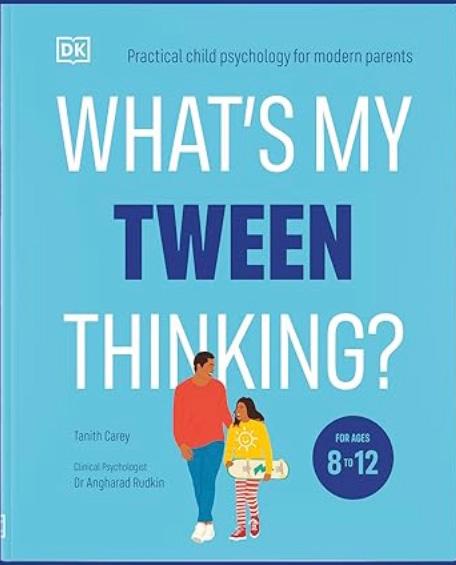
‘What’s My Tween Thinking? Practical Child Psychology for Modern Parents’ by Tanith Carey with Dr Angharad Rudkin is out now (DK books, £16.99).
happiful.com | Issue 86 | 35
relationships
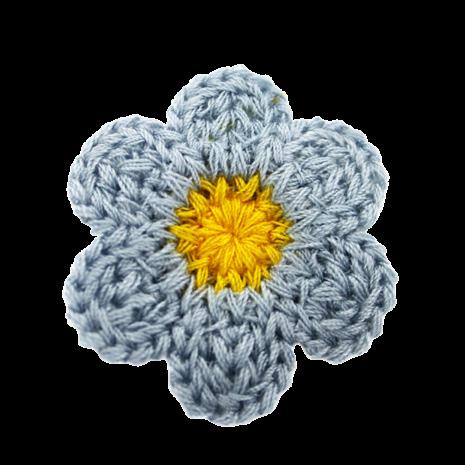

A ROOM OF ONE’S OWN
Where and when do you feel most creative? And could uncovering your ideal conditions for working be key to pursuing your dreams?
Writing | Caroline Butterwick
The kitchen table, the sofa, a bench… There is no limit, really, on the space we can use to work creatively. Some people flourish in a dedicated studio where they are away from interruptions, whereas others can perch themselves anywhere. For many, though, there are still conditions that can support our creativity, and realising what these are can help us with our artistic pursuits.
NURTURING CREATIVITY
“When we nurture our creativity, we are connecting with our inner child,” says registered therapist Emily Knivett. “If we know more about what makes us feel curious, open, and arty, we have another space to turn to when life gets disheartening. We can discover solutions to problems, and we can come up with new ideas. Creativity is linked with calmness, and that is a state we want to channel.”
I’ve been writing for most of my life, from going along to my local writers’ group as a teenager to studying creative writing at university, and working as a professional writer for the past few years. Throughout my writing
journey, I’ve been conscious about what does, and doesn’t, nurture my creativity, and this is true for many artists, whether a painter or a potter, a crafter or a cook.
It doesn’t matter whether you see yourself as a full-time artist or just want to dedicate a little more time to creativity. Perhaps you have an idea for a novel that you’re struggling to get started on, or you want to compose a new song, but seem to get distracted anytime you pick up the guitar.
“I recommend following your passions and notice where you feel joy, and follow that,” says Emily. “When have you felt the most free? Think back to when you were a child, what did you spend hours doing? Did you write stories? Or perhaps you went to a dance class where you could express yourself physically. Not all of us have experienced much play in our childhoods, so perhaps you could be brave and step a bit outside your comfort zone, and you may discover a new hobby. When you are being creative, try to be kind to yourself, especially if you are trying something new.
Allow yourself time to observe, take it at your own pace and try to embrace making ‘mistakes’.”
In her essay, A Room of One’s Own, published in 1929, author Virginia Woolf wrote of how “a woman must have money and a room of her own if she is to write fiction”, and considered the societal and financial conditions that can prevent women from being able to produce creative works. It’s an important reminder that, for many of us, there are barriers beyond our control that can make it harder to create – whether a demanding job, caring responsibilities, or managing a health condition.
We can also think about what can help us as individuals to foster the conditions in which we can best work. This can be the physical environment, which could be a room of your own where you’re able to be creative away from distractions, or having a corner of the kitchen counter where you feel comfortable. Or you may find the ideas flow best when you’re around others.
Personally, while I work from home, I regularly write in coffee
36 | Issue 86 | happiful.com

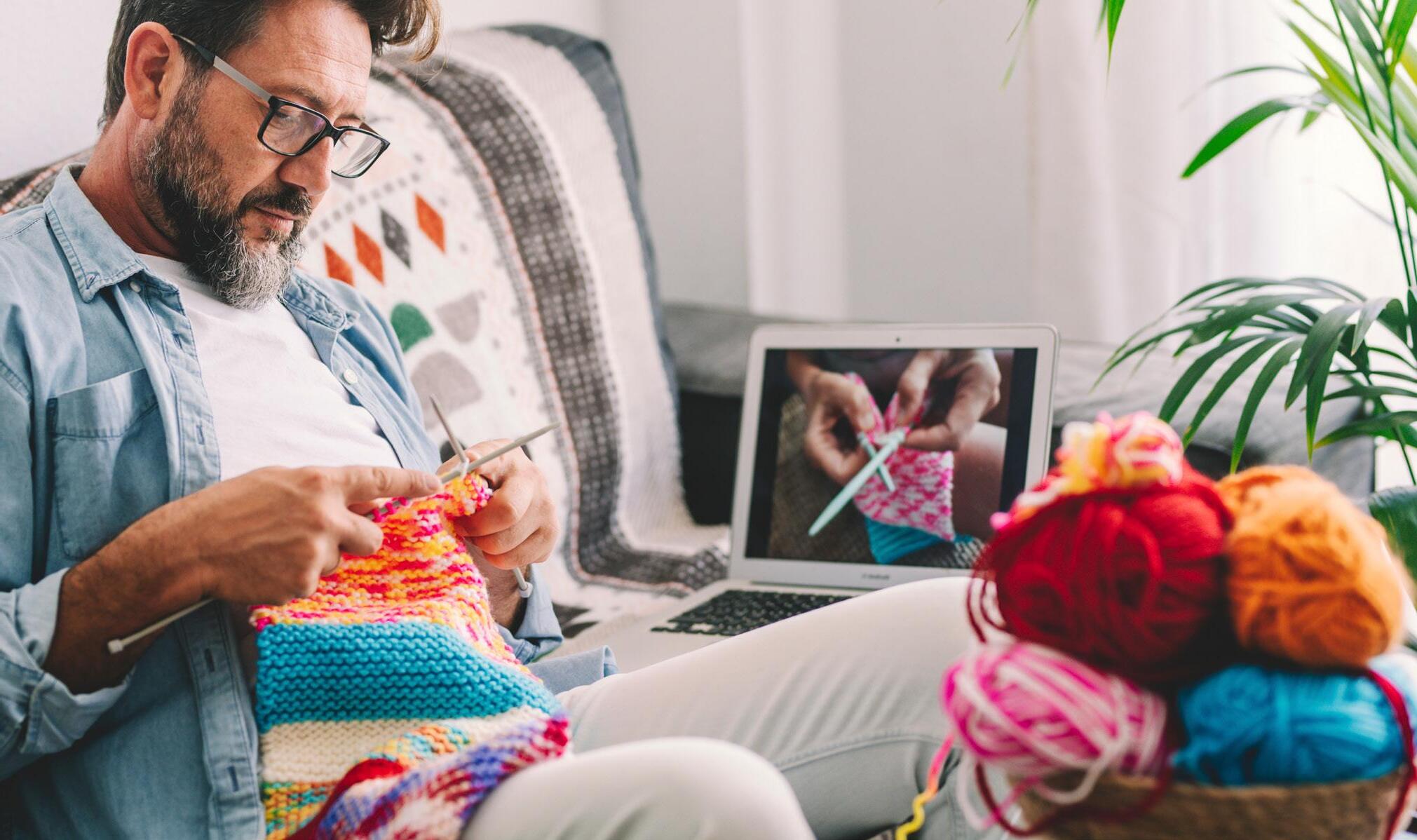
E.g. do you find a pen and paper easier to write with than your laptop?
• Do you prefer to work in a space by yourself, or around other people?
FINDING WHAT WORKS FOR YOU
It can help to take note, perhaps over the course of a week or month, of what helps kindle your creativity. A few things to consider are:
• Is there a certain place, or places, that help, and does this vary depending on what you’re working on?
• What time of day do you feel most creative and able to focus?
• Do you find it easier to work when there is noise or silence?
• If you’re working with others, do they need to be working on similar things, or is it just about being near people?
• What would the physical space you work at be like?
• What tends to distract you?
• When and where have you felt most able to work creatively? Can you pinpoint what it was about this that made it ideal?


It can take time to realise what works for you, and you may be surprised along the way, perhaps learning that your mind feels freest when you get up early, or that you love sketching in the street. What nurtures our creativity can also change with time, and depending on what we’re working with, so while realising what supports us is helpful, creativity can be sparked in so many ways. shops, especially when I hit a creative block – there’s something about the walk to my local café and then being around people that make a difference (a nice coffee also helps).
and have high expectations of ourselves, we can restrict our creativity,” says Emily. Waiting to paint a masterpiece until you have the dream studio with a beautiful view may mean the canvas stays forever blank.
• What materials do you need?
Of course, it’s important not to get too set in the idea that there must be the ‘perfect’ conditions for you to be creative. “If we try to set up specific, rigid conditions,
happiful.com | Issue 86 | 37 CREATIVE CORNER
Emily Knivett is a registered therapist. Head to the Counselling Directory to discover more.
How to handle living in someone’s shadow
How to handle living in someone’s shadow
Is there a relative, friend, or work colleague who always makes you feel like a failure? Here are five tips to help you find your own place in the spotlight
Writing | Victoria Stokes
No matter what you do, they seem to do it better. Whether it’s a sibling who has always outshone your achievements, or an equally talented colleague who seems to get all the praise while you get next to none, living in someone else’s shadow can be an incredibly painful experience.
Left unchecked, it feeds into feelings of inadequacy, anxiety, and low self-esteem. It can even contribute to feelings of resentment, frustration, and hopelessness. You might ask yourself: “What’s the point in even trying when they always outshine me?”
Counsellor Georgina Sturmer says it’s a natural instinct to
compare ourselves with those closest to us. On the one hand, it’s how we learn, grow, celebrate success, and share experiences with each other. On the other, it’s how we measure our perceived shortcomings. And one person can become our yardstick for success.
When you measure your achievements against theirs and fall short, it can be the catalyst for feelings of ‘not enoughness’. And the more you watch them succeed, the more you feel like a failure.
If you aren’t careful, living in someone else’s shadow can slowly erode your confidence, selfimage, and self-worth. So, how do you handle it?
NOTICE YOUR TRIGGERS
Ask yourself this: when do you feel most triggered by this person? Is it when they’re working the room at a social event, or getting plenty of praise and acclaim from those around them?
Make a note of your triggers. This will allow you to notice patterns, and it paves the way for self-reflection.
With these insights, Georgina says you’ll be able to plan how to protect yourself and work out in advance what you need to do or say to feel ‘enough’.
GET CURIOUS
Now it’s time to dig a little deeper. You’ll want to ask yourself some >>>
38 | Issue 86 | happiful.com

When you measure your achievements against theirs and fall short, it can be the catalyst for feelings of ‘not enoughness’
Remind yourself of what you have achieved, even if it feels as if other people might overlook those achievements
pointed questions about why this person makes you feel inferior.
Maybe you’ve always felt your social skills are lacking, but this person is the life and soul of the party. Perhaps you’re annoyed they’re getting all the praise at work, because – if you’re being totally honest – you’re worried your own work isn’t up to scratch.
Generally speaking, Georgina says, these people trigger us because they shine a light on our own perceived failures or lack of achievement. Using a journal to document your thoughts throughout this process can be beneficial.
HUMANISE THEM
Often, when we feel overshadowed, we put other people on a pedestal. Georgina says it can be helpful to remember that we all have insecurities and experience struggles and challenges – even the person who seems to outshine you.
“You never know, perhaps this person has a fear of failure, or gets trapped in a cycle of perfectionism, too,” she points out.
Remembering that this person also has insecurities and imperfections, and may well have felt overshadowed at some point in their life, does two things.
First, it can remove the stigma and embarrassment that
often comes with this kind of comparison, because you’re able to see that many people – even the ones we idolise – sometimes feel overlooked.
Second, it fosters empathy and compassion, because you’re able to see this person as someone who is simply doing their best, just as you are.
CELEBRATE YOUR OWN SUCCESSES
“We all have the capacity to be proactive in building our own self-esteem,” says Georgina, “so think about how you can remind yourself of what you have achieved, even if it feels as if other people might overlook those achievements.”
You might like to make a list and refer to it when you’re feeling low. And for an extra boost, consider celebrating successes outside of the areas where your friend typically succeeds.
If they often outshine you at work, you could make a conscious effort to note your accomplishments at the gym, for example.
FIND OTHER OUTLETS
Georgina says if we’re constantly experiencing an unfavourable comparison – whether that comparison is inside our own heads or from those around

us – it’s likely to impact on our confidence.
That’s why finding a way to differentiate yourself from this person is key. It could mean taking up a new hobby that you know you’ll excel at, or asking to spearhead a project at work that plays to your strengths instead of theirs.
This process allows you to rebuild your self-esteem. By finding new outlets that you enjoy, you can step out of their shadow and find your own way to shine.

Georgina Sturmer is an integrative counsellor helping client create a more confident life. Visit the Counselling Directory to get in touch.
40 | Issue 86 | happiful.com
Happiful reads...
From a handbook showing us how to brighten our homes, to a nature diary documenting Cornwall’s wild treasures, here are four reads ready to add to your list of must-haves
Writing | Lauren Bromley-Bird
Life doesn’t always go the way we intend it to. We experience love, peace, and good times, but we also experience loss, unexpected setbacks, and challenges. And though these difficult times can cause us great uncertainty and difficult feelings, it’s an
Must reads
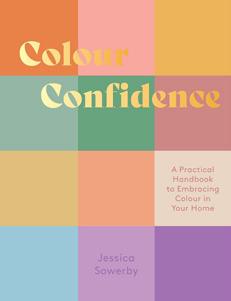
Colour Confidence: A Practical Handbook to Embracing Colour in Your Home by Jessica Sowerby
Creating a wellbeing sanctuary within our living spaces is important when we spend the majority of our time at home, and one way of achieving this is through the use of colour. With Colour Confidence as your guide, you can discover how to use colour to transform your space and mood.

opportunity for personal growth and self-discovery.
So, how can we strengthen our emotional agility, and reframe our mindset so that we use these circumstances as opportunities for good? Buddhist teacher Haemin Sunim enlightens us with his powerful wisdom that

Wild Treasures: A Year of Extraordinary Encounters with Cornwall’s Wildlife by Hannah Stitfall
Cornwall is home to some of the nation’s most remarkable creatures, and, luckily for us, Hannah spends the majority of her time photographing and filming them. In celebration of our wildlife, she invites us to take a peek into her nature diary, and read all about her encounters with wildlife throughout the seasons.
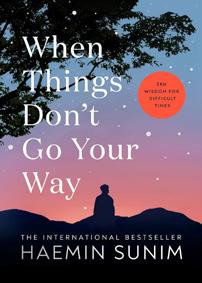
When Things Don’t Go Your Way by Haemin Sunim
comes directly from the heart, accompanied by his comforting illustrations.

Eating Disorders Don’t Discriminate: Stories of Illness, Hope and Recovery from Diverse Voices
Tackling the stereotypes and misconceptions about what eating disorders look like and who they impact, this powerful book provides insight into the way eating disorders present themselves from the experiences of athletes, activists, directors, models, and health professionals, and gives a voice to those struggling and feeling underrepresented.
happiful.com | Issue 86 | 41

“The moment you doubt whether you can fly, you cease for ever to be able to do it
J M BARRIE
42 | Issue 86 | happiful.com
Photograph | Sam Jhay
The difference between feeling good and mania
Whether it’s to prevent misconceptions or experiences being minimised, or to highlight signs someone is entering a manic episode, being aware of the difference between joy and mania is valuable knowledge that could ensure people get the help they need…
Writing | Kai Conibear
If you live with bipolar disorder, a constant problem is learning to recognise whether you’re just feeling good, or in the early stages of hypomania or mania. Hypomania and mania can be sneaky, and creep up on you without you realising. One day you’re feeling productive and happy, then a few weeks later you find yourself in a full blown manic or hypomanic episode. A sign of mania, for me, is reckless driving. It’s also extreme overspending, and finding myself in masses of debt that takes years to clear. It manifests as an irrational, intense anger toward everything and everyone. It’s believing I can rule the world, and anything is possible. It can also be hearing voices that boost my self-belief. But developing my
self-understanding allowed me to recognise these personal warning signs; they can vary from person to person.
To delve into recognising the difference between feeling good and mania, I spoke to counselling psychologist and trauma specialist Dr Rebecca O’Sullivan.
“Feeling good usually refers to a state of happiness that most people experience from time to time. It is moderate in its intensity, and does not tend to last for an extended period of time,” Dr O’Sullivan explains. “When we are feeling happy, our daily functioning is not significantly affected, and we can continue with our usual activities without much disruption. Happiness typically arises from positive life events and experiences, and does not tend to follow any patterns of occurrence.”
On the other hand, Dr O’Sullivan describes mania and hypomania to be a level of mood elevation beyond what would be considered ‘normal’. “This is more intense than ‘feeling good’, in fact, some people describe the experience as euphoria,” she says. “This euphoria occurs as a recurring pattern of mood swings; in the case of bipolar disorder, it would alternate with episodes of depression. During hypomania/mania episodes, people tend to experience high energy levels and a sharp increase in productivity. Unlike happiness, this euphoric state is a more long withstanding experience, lasting anywhere from a few days to a few weeks.” >>>
happiful.com | Issue 86 | 43
your space
An important point to note, that many people may not realise, is that mania doesn’t always feel good. A common misconception is mania means you’re always the life of the party, feeling ecstatic, and full of energy and productivity. And yes, life does feel brighter, but it can be as selfdestructive and life threatening as depression. It can feel so glaring and loud, like your senses are overloaded. It can be irritating and unpleasant. I will often feel like raging and screaming because of the pressure building inside of my head, but there’s no release valve.
Exploring this further, Dr O’Sullivan explains how hypomania/mania can have a significant impact on a person’s daily life. “During these times, some people notice an increase in risky behaviours, have trouble concentrating, racing thoughts, and difficulties sleeping.
Understandably, this can have a marked impact on our ability to complete everyday tasks, and other important areas of life (e.g. relationships, work).
“It is interesting to note that – although it can occur spontaneously – hypomania/ mania can also be triggered by stress, lack of sleep, substance abuse, or medication changes (which provides a contrast to the usual positive triggers of happiness or ‘feeling good’).”

Being conscious of potential triggers is always useful, as hypomania in its early stages can be difficult to spot as the lesser extreme of mania, but it is still serious and important to monitor. While experiencing it, your selfconfidence is unbound, you feel constantly restless, and itching to start that new project you’ve been dreaming about. A good mood and hypomania can present as extremely similar to an outsider, and even the same to yourself.
I’ve personally experienced this scenario, and was in a hypomanic
state when family and friends believed I was just happy. What they didn’t see was that I was constantly ‘on’, like a light with a faulty switch that can never be turned off until you fix the problem. It’s a dangerous time, as relentless energy pushes you on to do more and more. You may find it difficult to sleep or eat because your mind is so active; it needs to be satiated with action and excitement. If this isn’t addressed and treated, for some, hypomania can turn into mania.
44 | Issue 86 | happiful.com
10 signs of mania/hypomania
Whether it’s awareness for yourself, or to help you be on the alert for loved ones, there are some common signs to watch out for, which Dr Rebecca O’Sullivan shares:
• Elevated mood. Persistent feelings of euphoria or extreme happiness that last multiple days.
• Increased energy. Unusually high levels of energy, even without sufficient rest and sleep.
• Sleep. Feeling rested after only a few hours sleep, or after experiences of insomnia.
• Racing thoughts. Quickly jumping from one idea to the next, difficulty staying on task.
• Increased talkativeness. Speaking more rapidly than usual, engaging excessively in conversations, or interrupting others.
• Grandiosity. Inflated sense of self-confidence, or beliefs around having special powers or abilities.
• Impulsivity. Engaging in risky behaviours without considering the consequences, or impulsive decision-making.
• Irritability. Becoming easily annoyed or angered over what would otherwise be considered minor issues.
• Changes in behaviour or personality. Acting ‘out of character’ or behaving in a way that would be seen as unusual for the individual.
• Increased libido. Heightened sexual desire, or engaging in risky sexual behaviours.
One of these symptoms that particularly stands out to me is how someone experiencing mania/hypomania’s speech quickens, and they’re always waiting eagerly for their turn to talk. When they do, the speech is often pressured, and they may speak more than they usually do, or what feels like non-stop.
It’s worth noting that symptoms can differ from person to person, but if you’re exhibiting signs of experiencing hypomania/mania,
it’s better to seek out help as soon as possible. A few key indicators that it’s time to reach out for professional help, according to Dr Rebecca O’Sullivan, include:
• Symptom persistence
• Interference with daily life
• Risk of harm (to themselves or others)
• Sleep disturbances (significant changes to sleep patterns, accompanied by other symptoms)
• Concern from others (where external people have expressed concern about changes to your/ their mood and behaviour)
• A history of bipolar disorder (or they have previously experienced episodes of hypomania or mania).
Feeling good, happy, or optimistic are incredibly different emotions to hypomania/mania. While we all strive to feel good, or at least content, hypomania/ mania are symptoms of being unwell, and can be unsettling, destructive, and even dangerous for the person experiencing them. But, by learning about the signs to watch out for, and seeking appropriate treatment, hypomania/mania can be managed and avoided, and individuals can thrive and learn to enjoy just ‘feeling good.’
Kai Conibear is a writer and mental health advocate. His first book, ‘Living at the Speed of Light’, about bipolar disorder, is out now.

Dr Rebecca O’Sullivan is a psychologist working with complex trauma. Get in touch via her profile on the Counselling Directory.
happiful.com | Issue 86 | 45
your space
Back to reality
With millions of viewers across the globe tuning-in to the constant stream of reality TV, from Married at First Sight to Love is Blind, columnist Michelle Elman reveals four communication lessons we can take from these dating shows, and how relationships play out
Reality TV has a bad reputation as ‘trash telly’ but, as a psychology nerd, my appreciation for it stems from my fascination with human behaviour – especially when it comes to shows that revolve around love. I believe you can learn a lot from them as it is often easier to see your own behaviours in an external way. There might be people you relate to, but also be people who annoy you because their behaviour actually reminds you of your own…
So, here I’m revealing four lessons you can take from reality TV to help foster healthy relationships, and better recognise romantic red flags.
Body language tells you a lot.
The hit Netflix show Love Is Blind features couples getting engaged without ever seeing each other in person, and while the premise is about valuing compatibility over looks, I wonder if there’s a fundamental flaw in that while those on the show can’t be swayed by appearance, they also can’t read each other’s body language and subconscious signals.
In the most recent series’ reunion show, we caught up with a couple
(Sarah Ann and Jeramey) who met in the pods, but got together after he proposed to another woman on the show (Laura). What I found particularly interesting was during an old clip of the two women talking, anytime Laura said anything negative about Jeramey, Sarah Ann nodded along. It appeared to be an unconscious response, but when another participant revealed to the audience that every time she has seen Jeramey since filming he and Sarah Ann had been broken up, it all started to make sense.
While Sarah Ann may have stood defiant in the face of criticism of her actions and accusations that she broke up the couple, and was insistent it was worth it, the truth was that she was encountering the same turbulent relationship with Jeramey that Laura experienced.
Similarly, in Married at First Sight, the couples are always sure to be cosy and affectionate when they are in the spotlight and talking to the experts, but the moment they are sitting to the side and another couple is being interviewed, it is amazing to watch how quickly they separate from each other.
As an external viewer, it is much easier to see these small giveaways in body language, but try to pay attention to them on your next date. If a person starts telling you that you should trust them, but are shaking their head no as they say that, take their words with a pinch of salt. It’s easy for them to say what you want to hear.
People will tell you who they are very early on.
A narrative that played out on Love is Blind season six was how Chelsea’s insecurities contributed to the break-down of her relationship with Jimmy, as it appeared that she sought constant reassurance of his feelings, while he became increasingly frustrated that nothing he did felt like enough.
While outsiders can empathise with both sides, and social media went into a frenzy about Chelsea bringing up appearances and celebrity dopplegangers in the pods, another sign I spotted that her self-esteem would come into play was in the first episode, where Chelsea recounted dates where guys watched football on
46 | Issue 86 | happiful.com
Writing | Michelle Elman

screens behind her. It may have been a passing comment, but it showed that she didn’t see herself as worthy of someone’s full focus and energy. Personally, I would not have sat there and endured it, because as much as it’s bad behaviour on the date’s part, it is also telling that you tolerated it. Romantic red flags aren’t always in others, sometimes they can be in ourselves, and it’s important to recognise where we have things to work on in order to better thrive in relationships – in this case, building our self-esteem before looking for love, or seeking validation from others that we should be able to provide ourselves.
There is no point noticing a red flag if you don’t act on it.
In the current season of Married At First Sight Australia, we hear a man yell at a different couple, telling the man to “muzzle your woman” – and yet his own wife pays no mind. She doesn’t see his behaviour as an issue, and even defends him by saying that he has a dark sense of humour.
It takes multiple conversations with the experts for her to see why this is a problem, and even then, she doesn’t confront it, because she doesn’t want to rock the boat in her relationship. The fact is, if a man can talk to another woman like that, then he can talk to you like that. But more than that, there is
never any reason to talk to a woman like that, and therefore, she should be seeing the warning signs of misogynistic behaviour.
For me, this is a prime example of when we bury our heads in the sand, it is only a temporary solution before we will see more of that pattern of behaviour. We can’t be surprised that ignoring the writing on the wall has only negative consequences.
If you look for a problem, you will find one.
In many of these shows, we see people who do not believe they are deserving of love, and how those insecurities play up within a relationship. Largely, this occurs by picking fights, which are rarely about the underlying issue. Whether it’s someone flirting with another, or saying they want to see if the other person will fight for them, as outsiders we can see what happens when we aren’t selfaware and project our feelings onto others.
So, next time someone judges you for your taste in TV, don’t feel guilty. Reality TV can be relationship research, helping you see the pitfalls of communication crossed wires, and how to untangle them.

Michelle Elman is an author, TEDx speaker, and five-board accredited life coach. Follow her on Instagram @michellelelman
happiful.com | Issue 86 | 47 @MICHELLELELMAN
Tips for supporting your autistic friend
From learning about special interests to communicating in different ways, here’s what you can do to deepen your friendship
Writing | Lydia Wilkins
Iam autistic, and I have been diagnosed for almost a decade. I’m also an awardwinning freelance journalist, an editor, and an author. Sometimes I am recognised as an expert in my field, too. But, in law, I am recognised as a disabled person – with some ‘extras’ I need to take account of.
My diagnosis makes me a member of the least employed disability group, as well as more likely to be at risk from issues such as addiction, poor mental health, economic violence, and friendship-related issues – the latter being a topic of imperative importance. We are targets for ‘mate crime’, and many experience bullying – but we often hanker for connection, too. These are a few hacks that I would like the other side of the aisle to know about when it comes to how to support your friend(s), who also happens to be autistic.
Read up about their ‘special interest’
A special interest is a hallmark of the autistic spectrum, and refers to when someone is compelled to
learn as much as possible about any given topic or concept, often in detail that may seem abnormal to other people. They are not ‘obsessions’, and they are fundamental to good mental health in an autistic person. This can be anything from carrots to Agatha Christie novels. To know that there is another person who has some awareness about the interest is like gold dust; something to connect about. So read up about the special interest, ask us about it, talk about it, and what it means – it’s a way to make a meaningful connection.
Think about the social setting and accommodations
An autistic individual may experience sensory issues, but they can be accommodated. Each sensory profile is different; some of us cannot abide noise, while others need to lap up any extra stimulation. Every autistic person is different, so ask us what our sensory needs are, and take those into account when socialising. If you’re going on holiday, there are sensory rooms
in airports that can be booked. AccessAble is a company that offers information across a range of venues to give you the autonomy to decide where to go. This will mean everyone can enjoy the social occasion.
Be aware of change and surprises
A surprise can be a lovely thing – if you’re not on the autistic spectrum. A surprise is something that has a weight to it, and is a social expectation that we might not be able to read – the anxiety that this can induce is overwhelming. The same goes for change; it is not a concept that we are able to completely avoid in life, but we need time to get used to it, and to work out the anxiety and the overwhelm that this can cause. For example, if you’re going to be late, let us know as soon as possible. Setting up this context allows us to adjust, as well as to have time to prepare ourselves.
Direct communication is a virtue
The ‘double empathy problem’ is a theory that suggests that,
48 | Issue 86 | happiful.com
Read up about the special interest, ask us about it, talk about it, and what it means

contrary to popular wisdom where communication is a ‘twoway’ connection, when it comes to autistic people this is often not the case – and that when people with very different experiences of the world interact, they may struggle to empathise with each other. An autistic person has to do the ‘work’ of a conversation –e.g. constructing their speech, ‘translating’ it to be understood by a non-autistic individual – while also having to take into account things such as inflection, tone, and being palatable enough to be understood and received. This is a lot of work for us, and it is deeply refreshing if the noise in the background is cut out. Therefore, direct communication is a virtue, and make sure that you are prepared for us to answer directly.
Think of ‘the pebble theory’ Penguins are known for giving prospective partners a pebble as a gift, something which sparked ‘pebble theory’, which refers to sincere, small actions that can include gift-giving in a friendship or relationship.
Sometimes, an autistic individual may express their emotions differently, such as by ‘doing’ rather than ‘saying’. So, giving a ‘pebble’, rather than verbalising said affection by saying ‘I love you’. Keep this in mind throughout your friendship, get to know their ‘love language’ in that respect, and treasure those ‘pebbles’.
happiful.com | Issue 86 | 49 wellbeing
The difference between gratitude and toxic positivity
While, on the face of it, you might perceive these two things as similar, in reality the attitude and intention behind them couldn’t be more different.
Toxic positivity
Focus only on the good.
No crying or complaining. Life is so much harder for countless others.
Gratitude
I appreciate the good moments in life, and recognise the lessons learned from challenges.
We all face uniquely difficult experiences. I’m grateful for the support I have in place to help me through it.
Just be grateful things aren’t worse.
There’s always a silver lining.
Don’t be so negative!
I can be thankful for many things in my life, while still struggling with others.
It can be hard to make sense of tough times, but perhaps one day I can look back on this differently.
Recognising my pain isn’t a failing. Addressing my feelings, rather than pushing them away is healthy.
Complex feelings can and do co-exist. Don’t feel you have to hide them behind toxic positivity. Instead, practise gratitude as a tool to help you navigate tough times, while acknowledging and validating your full emotional experience.
50 | Issue 86 | happiful.com
Take 5
Put those little grey cells to the test with these brain teasers
Rebus puzzles
Also known as ‘picture riddles’, think ‘literally’ to uncover these common sayings and expressions.
Tip: Consider the word placement, direction, numbers, and colours, to give you the best chance of success!
CROSS SUM
Use the digits 1 to 9 in the grid in order to solve six different sums. Each number can only be used once, and the operations in each equation (+, -, x, ÷) apply left to right, or top to bottom. Thinking caps at the ready...
do?Howdidyou Visit the ‘Freebies’ section onshop.happiful.com tofindtheanswers, and more!
META META META META POT oo oo oo oo AM OUS U T A H W M U S T MOONCEON TR OU BLE ONCE LEAST + - =11 ÷ x + x ÷ =4 - ÷ x + x =12 =2 =28 =44
THE POWER OF
pausing
How to make the most of microbreaks
Writing | Lara Green
The proof of a productive day is often linked to packing in as many hours as possible. Waking up earlier, powering through lunch, backto-back meetings, taking calls when we’re off – these actions have been normalised into contemporary working life, tipping into our down time in the name of achieving more. On the face of it, it makes sense. Working more = greater productivity. Greater productivity = a better reputation at work. A better reputation = a chance of getting ahead. But we have to ask ourselves: what is this high-octane work culture doing to our wellbeing? Are we really getting more done? Or is there a more balanced and sustainable approach that fosters
productivity, creativity, and advancement at work, with big wellness wins, too?
A pause for productivity
The popular narrative might be to hustle hard 24/7, but planning pauses in your day is highly unlikely to hinder output. In fact, studies suggest it can actually boost it and enhance productivity and reduce stress.
It’s all thought to come down to our ‘ultradian rhythm’: a series of 90-minute, recurrent biological cycles that our bodies follow throughout the day. We’re in the high focus zone during the first 90 minutes, but as the cycle progresses, focus wanes and productivity suffers.
Pausing is a way to renew that focus and refresh the skills we
need to thrive at work – like solving problems, being creative, and making confident decisions. By purposefully stepping away from the task at hand, and following the natural ebb and flow of our energy cycle, we create space for activities that lift us, injecting a renewed sense of vigour when we head back to our assignments.
Indeed, a simple cup of tea and a book might be just the ticket for a mid-morning boost. But what if you were to try other things that provide a deeper sense of self, nurture creativity, and present an opportunity to grow physically, emotionally, and spiritually?
An ikigai approach
Personal and professional development coach Helen Robinson says: “Having purposeful
52 | Issue 86 | happiful.com
breaks can encompass two distinct meanings: firstly, intending to take a break, and secondly, deriving value from that break.”
Where you find that value exactly will likely come down to personal preference and interests, but the Japanese custom of ikigai can be a useful place to start.
“Ikigai offers a unique perspective on how we can maximise work breaks to enhance wellbeing and positivity,” says Helen. “The most concise translation of ikigai is finding value in daily living. It embodies a sense of purpose, meaning, and joy in our existence. It’s about consciously living in alignment with one’s purpose, which fosters meaning and contentment.”
It certainly stacks up that people who are tuned into ikigai tend to be more content and motivated. And it’s believed to be linked to lower levels of depression and higher selfesteem too, influencing all areas of life, including work, with one study published in the International Journal of Mental Health and Addiction finding that participants who engaged with ikigai had a high predictability of strong mental wellbeing, alongside low scores on measures of depression.
Purposeful pauses versus procrastination
Most of us will be familiar with work procrastination via those nagging, un-ticked tasks that sit unnervingly in the back of our >>>


minds. And yet, the more we dread a task, the more we find ways to put it off. You might think that your current habit of social media scrolling could count as a break, but the reality is that procrastination activities such as this can overload our prefrontal cortex, and don’t leave us with that sense of accomplishment, or rejuvenation we need from a purposeful pause. In fact, a 2018 study, published in the Journal of Social and Clinical Psychology, found a causal link between excessive social media use and increased feelings of depression and loneliness.
This intention behind how you spend your time is the key difference between

microbreaks and procrastination –the former being a way to recharge your energy supplies, and stimulate yourself with fulfilling or rewarding activities, while the latter is an avoidance technique, that most likely leaves you feeling more drained and stressed as it seems like you’ve not made progress, or replenished yourself at all.
Rather than mindlessly reaching for your phone throughout the day, microbreaks bring routine to the fore, and help us lean towards productivity in a healthy, balanced way. Think about activities you want to do that
encourage creativity, movement, or a connection. These types of breaks shift us away from procrastination and help to improve motivation.
3 ways to make the most of microbreaks
1. Build your break bank. From finding your ikigai, to recognising what self-care practices refill your cup, create a bank of activities to stimulate
54 | Issue 86 | happiful.com
your senses while taking a purposeful pause. We all have a unique set of emotional and physical needs; if you’re an active person, a break might be a 30-minute power walk. For creative blocks, colour, music, or nature might be just the salve to spark new ideas. By having a range of options, and assessing what we need from breaks, we can effectively pull from the break bank to best support ourselves. And, what you’ll often find is that the culmination of these microbreaks over the course of the day leaves you feeling far more fulfilled by the end of it. When you’re more intentional with your time, you’ll feel less emotionally drained, have a greater sense of achievement, and find that balance of ticking off the work to-do list, while also honouring your own wants and needs.
2. Grow awareness of your ultradian rhythm. Whether it’s 60 seconds of nature gazing or 30 minutes of ikigai, every break that shifts your perspective is a wellness win. And while common time management tools like the Pomodoro technique (25-minute stretches of work broken up by five-minute breaks) can help set a healthy routine, the timing of your breaks – and how long you break for – is best led by your innate understanding of your ultradian rhythm and what you need in that moment.
While the typical energy cycle is believed to be about 90 minutes, it’s worth developing
a stronger awareness of how your personal energy and attention fluctuates. You might want to use a digital tracker, or simply a notebook, to record the times throughout your typical day when you’re flagging, and experiment with what microbreak serves you best at these various moments. For example, disengaging from work only for a few minutes, but on a regular basis, can be all you need for a sufficient break in the morning. Mental fatigue tends to set in more in the afternoon, so scheduling longer breaks can be beneficial at that point.
3. Recognise procrastination. And tackle it head on by planning purposeful breaks that give you a renewed sense of focus. By injecting activities into your day that serve you on a self-care level, you can refrain from falling into the negative spiral of procrastination that can trigger things like poor decision-making and avoiding tasks. Microbreaks have the ability to shift you into the realm of ‘doing’ rather than ‘avoiding’, and are a great way to retrain the mind.
You can approach this in two ways: when creating your to-do list, plan in microbreaks and what activities you intend to do in that time; or when you notice yourself procrastinating, take it as a sign you need a purposeful pause, and instead refer back to your break bank to choose something that serves your wellbeing better.
Following the natural ebb and flow of our energy cycle, we create space for activities that lift us, injecting a renewed sense of vigour when we head back to our assignments
Enabling productive pauses can be hugely empowering – unlocking a new sense of self-awareness that can help us truly flourish in life and work. So, next time you feel guilty for having a breather, remember: taking a break can be pretty productive after all.
Lara Green is a writer, recipe creator, and sourdough bread teacher. Follow her on Instagram @_fromthegreenkitchen

Helen Robinson is a coach helping people make the most out of their lives by finding their purpose. Find more insight on the Life Coach Directory.
happiful.com | Issue 86 | 55
your space
Unravelling the mystery of manifesting
We are starting to hear more people talk about the magic of manifesting, but what exactly is this mysterious concept, and is there any evidence to prove it works?
The concept of manifesting suggests that individuals can think, visualise, and believe their goals into reality. It’s often associated with the ‘law of attraction’, based on the idea that our thoughts impact our beliefs, behaviours, and consequently our outcomes.
While the effectiveness of manifesting is not supported by scientific evidence, research does indicate that people who believe they have control over their lives (known as internal locus of control) are more likely to achieve their goals than those who rely heavily on fate – highlighted in a 2022 Frontiers in Psychology article that reviewed this concept from an entrepreneurial angle. This belief in personal agency is consistent with having a growth mindset, and contrasts the often misunderstood ‘passive approach’ to manifesting, implying that people can materialise their goals through thoughts and beliefs alone.
So, while there isn’t conclusive scientific evidence to support manifesting, studies suggest
that having a positive attitude can influence our approach to achieving goals, especially when accompanied by inspired actions.
As an advocate of manifesting, here I will share five steps that can support you to align your thoughts, feelings, and actions with your desired outcomes, to help you create the reality you truly deserve.
STEP 1: DECIDE WHAT YOU WANT.
Although this sounds obvious, many people are vague or unclear about what they really want, and instead focus their attention on what they do not want. To manifest effectively, you need to be specific about what makes you light up from within.
To fine tune your desires, write them down in as much detail as possible, e.g. instead of “I want to be happy”, say “I want to wake up every morning feeling grateful for my life. I want a fulfilling career, where I make a positive impact on the world. I want to travel, and experience different cultures.”

Nikita is a multifaceted teacher, mentor, and coach, combining transformative modalities to support people to find their life purpose. Visit the Therapy Directory for more.
Being sure of what you want creates a clear picture in your subconscious mind, which acts as a blueprint to work on attracting that very thing into your life.
STEP 2: VISUALISE IT HAPPENING.
This means that you not only imagine yourself having that outcome, but physiologically experience being in the desired state. E.g. if you are self-employed and your desire is to have lots of clients, you may imagine your diary being full, and conversations with prospective clients to explain that there’s a waiting list.
Visualising your desired outcome helps activate your imagination, which is one of the most powerful tools for creating your reality, according to neuroplasticity. Scientists say the brain has an amazing ability to adapt and
56 | Issue 86 | happiful.com
NLP
NIKITA THAKRAR
Portrait
| Julia Morris

rewire itself when engaged with positive self-talk and visualisation. Spiritualists say that when you visualise something, you send a signal to the universe that this is what you desire and deserve, and the universe responds by matching your vibration.
STEP 3: BELIEVE IT IS POSSIBLE.
The ability to trust that your desires can come true is arguably where most people stumble. Believing it is possible means to have faith and conviction that you are deserving of whatever it is that you want, and that it will come to you at the right time and in the right way.
Letting go of any doubt about how it will happen can be challenging for those who are governed by their logical mind. The most powerful manifesting is based on trusting the flow of opportunities that may present themselves when you are fully aligned with your authentic self. You may consider working with a coach to help eliminate limiting beliefs, and replace them with empowering ones that aid your vision.
STEP 4: TAKE ACTION TOWARDS IT.
This is the step that some people who advocate the law of attraction miss out! Taking positive and inspired action is fundamental,
as opposed to a ‘watch and wait’ approach. For me, this means doing something small every day that brings you closer to your desired outcome.
Many people misunderstand manifesting, and assume that we just sit back and wait for the universe to grant our wishes! In this step, we encourage you to take inspired and aligned action that matches your intention. This creates momentum and synchronicity in your life, which attracts opportunities, as well as boosting your confidence.
To do this, try breaking down your goal into small, manageable steps, and scheduling them into your daily routine. It is important to prioritise your tasks, along with tracking your progress, and celebrating your achievements.
STEP 5: LET GO OF THE OUTCOME.
This may seem counterproductive, but it simply means that you detach yourself from the result, and focus on the journey rather than the destination. Letting go allows you to enjoy the present moment and appreciate what you already have, rather than focusing on what you lack. It also boosts the immune system and improves sleep quality, bringing an overall sense of calm and wellbeing, as found by Seligman et al. in American Psychologist in 2005.
In my experience of following the steps discussed, you can create the reality you want and live the life you deserve. I believe that we are all powerful creators, and have the ability to manifest anything.
happiful.com | Issue 86 | 57 EXPERT COLUMN
Breakfast of champions
A twist on your classic beans on toast
Writing | Xuxa Milrose

Beans on toast is a perennial and pursefriendly breakfast, packed with all the nutrients you need to fuel both busy days and slow mornings. As an ingredient, beans are incredibly versatile, and are the perfect delivery vehicle for any flavour profile your heart desires! For this particular recipe, I’ve opted for kimchi beans – packed with flavour, they offer a blend of sweet, spicy, and umami.
Kimchi beans on sourdough with jammy boiled eggs and sesame seeds
Ingredients
• 1 tbsp olive oil
• 1 large white onion, finely diced
• 4 cloves of garlic, crushed
• 2 tbsp tomato puree
• 2 tbsp soy sauce/tamari
• 1 tbsp maple syrup
• 2 tsp smoked paprika
• 2 tins (approx 700g) of cooked cannellini beans
• 1 tbsp gochujang
• 400g tin of chopped tomatoes
• 250g kimchi, roughly chopped (as well as some kimchi juice from the jar)
• Salt and pepper to taste
• 3 eggs
• Sourdough bread
To serve
• 2 spring onions, finely chopped
• 1 tbsp sesame seeds
58 | Issue 86 | happiful.com
Method
• Heat the oil in a pan and add the diced onion, frying for 5–7 minutes on medium heat until the onions turn translucent. Add the crushed garlic and cook for 3 minutes.
• Add the tomato puree to the pan. Cook for 2 minutes before adding the soy sauce, maple syrup and smoked paprika. Give it all a good mix.
• Add the beans and the gochujang to the pan, stirring thoroughly before adding the chopped tomatoes, kimchi and kimchi juice.
• Cook for 10 minutes on medium-low heat until the sauce has reduced and thickened. Add salt and pepper to taste.
• For the perfect soft-boiled egg, fill a medium saucepan with water and bring to a rolling boil. Lower the eggs (room temperature) into the pan using a spoon – using room temperature eggs means they’ll be less likely to crack!
• Set your timer for 6–7 minutes. Remove the eggs and transfer to a bowl of cold water.
• Toast your bread. When the eggs are cool enough to touch, peel and slice in half.
• Serve the beans on the toasted sourdough and top with a hard-boiled egg, spring onions and sesame seeds.
The healthy bit
Beans not only boast an impressive profile of B vitamins, iron and folate – crucial for the transportation of oxygen around the body and energy production – but they’re also a brilliant source of fibre and plant-based protein. Including more beans in your diet may also help reduce cholesterol, decrease blood sugar levels, and increase the amount and diversity of beneficial bacteria in the gut.
Kimchi is a traditional Korean food made by fermenting vegetables. This fermentation produces lactic acid, which helps grow specific strains of live bacteria that can help populate our friendly gut bacteria. This aids in regulating immune function, promoting healthy digestion, and can even help improve mood and our response to stressors!
Studies have shown that the consumption of eggs raises the levels of HDL – often dubbed the ‘good cholesterol’ as it carries excess cholesterol to the liver, to be removed from the body.
Eggs are packed with vitamin A, folate, vitamins B2, B5, B12, vitamin D, E and selenium, all needed for energy production, proper immune function, and prevention of cell damage. They’re also an excellent source of choline – a nutrient crucial for
building cell membranes and helping to produce signalling molecules in the brain, impacting memory, muscle function, and mood. When available, try to opt for sourdough. To make sourdough, a ‘starter’ is used – a culture of yeasts and beneficial bacteria that naturally ferment before being mixed with flour to make the loaf. Although a lot of this beneficial bacteria is lost during the baking process, the fibre, minerals, and polyphenols become more bioavailable. This is because a naturally occurring compound found in grains called phytic acid gets broken down, meaning we can absorb and utilise the beneficial nutrients more efficiently.
The combination of fibre and protein from the beans, the protein and fat from the eggs, and the complex carbs from the sourdough, will ensure your blood sugar levels remain balanced, and that you feel energised, satiated, and ready to take on the day!
Xuxa Milrose is a nutritional therapist with an interest in the braingut connection and how food can support mental health and wellbeing. Get in touch via her profile on the Nutritionist Resource.

happiful.com | Issue 86 | 59
food & health
Recipe image provided by Xuxa Milrose
“It is not the mountain we conquer, but ourselves
SIR EDMUND HILLARY

60 | Issue 86 | happiful.com
Photograph | Andy Vu
What is worthsplaining
(and how can we stop)?
Feel the need to over-explain your actions and justify why you’ve done something? You could be worthsplaining…
Writing | Kat Nicholls
Picture the scene: you’re at work, and decide to go out to a restaurant for lunch. When you tell your coworkers your plan, you make sure they know this is a ‘treat’ and that you’ve saved money somewhere else this week, which is why you can afford it. Or perhaps you’ve been invited out for a drink, but all you really want is a night in. You say no to the invitation but then send multiple texts justifying why you need a night in (‘Work has been so full on!’ ‘I can feel a headache coming on!’ ‘The cat gets lonely!’).
Both of these are examples of worthsplaining. This is when we go to great lengths to justify our actions, often because we fear being judged. It may be somewhat of a habit you’ve fallen into, but it could have a negative impact on your mental health.
The fear of judgement driving worthsplaining can be due to low
self-esteem and self-worth. It can also be a sign that we’re seeking external validation for our actions, that it’s OK for us to make these choices for ourselves.
When we live in fear of what others think, and seek external validation, we chip away at our authentic self, and this is what impacts how we see ourselves, our self-esteem and, ultimately, our happiness. When we set healthy boundaries, feel confident in our decisions, and turn inwards for validation, we build ourselves up, feel good about who we are, and make choices that fulfil us.
So, if you have fallen into this habit of worthsplaining, how can you put a stop to it?
RECOGNISE THAT YOU’RE DOING IT
Awareness is the first step to stopping most habits, and it’s no different with worthsplaining.
Now that you know what it is, you’ll likely recognise it more easily. Try to tune-in with yourself when you need to make a decision, and notice how you react. Take some time to reflect on how you coped with the decision, and see if you’ve worthsplained to anyone.
Self-awareness can take practice, and building up a habit of reflection can really help.
Try journaling about your day, mood tracking, or even starting a meditation practice. All these activities encourage us to slow down and take stock, which builds our self-awareness.
QUESTION YOUR MOTIVES
Once you’re more aware of what you’re doing, you can dig a little deeper and ask why you’re doing it. For example, if you want a night in and find yourself justifying it, what’s driving this? Are you worried your friends will >>>
happiful.com | Issue 86 | 61
wellbeing

When we live in fear of what others think and seek external validation, we chip away at our authentic self




be upset with you for not going out? Do you struggle to make time for rest, and need to justify to yourself why you deserve it? Do you want your friends to agree with you, saying you deserve to rest, because you aren’t sure that you do?
This kind of examination can be done in several ways. You might want to journal it out alone, or you may find it helpful to work with a professional, such as a counsellor or coach, to unpick what’s going on.
SET SOME BOUNDARIES
Personal boundaries help you draw a line in the sand when it comes to what you will and won’t do. They allow you to protect your peace of mind, and can act as a powerful form of selfcare. Try to think about some situations where you tend to worthsplain, and set yourself some boundaries. These could be around how many things you say ‘yes’ to in a set timeframe, things you say ‘no’ to, how much you’re willing to take on at work, your spending habits, and more. Once you set these boundaries, you can check in with them when making decisions, helping you stay on track with what you need.
WORK ON YOUR SELF-TRUST
A lack of self-trust is often at the core of worthsplaining. You may not trust that you’re making the right decisions, or that you deserve certain things. Working on building that self-trust can go a long way in helping to overcome worthsplaining, and a few ways you can do that include: creating a more positive relationship with your inner critic (acknowledging comments and the intention to keep ourselves safe, but recognising we don’t have to act on or agree with them); making self-care a priority (scheduling in time to do things that refill your cup); recognise what a lack of selftrust feels like (allowing you to identify it, and pause to respond differently in future); and letting go of habits that undermine your self-trust.
LET YOUR DECISION STAND ALONE
This is perhaps the trickiest step, but also the most important. When you make a decision, try to let it stand alone, i.e. without worthsplaining to prop it up. For example, if you decide to go to a restaurant for lunch at work, simply say “I’m heading to
[PLACE] for lunch, I’ll see you in an hour.” Or, if you want a night in, say “Thanks so much for the invite, I’m going to skip this one and stay in –have fun!”
It may feel uncomfortable at first, not to explain or justify your actions, but the more you do it, the more your confidence in yourself will grow.
KEEP PRACTISING
To move past worthsplaining and to build up your sense of worth, it’s all about practice. Keep noticing your reactions, keep questioning your motives, keep checking in with your boundaries, keep working on your self-trust, and keep letting your decision stand alone.
As mentioned, working with a professional can help you understand what may be at the root of your fear of judgement, or desire for external validation. Here you can look at other areas of your life where your low sense of selfworth is affecting you and discover practices to help you build up your authentic self again.
If you want to do some selfexploratory work, journaling can be a great tool for this. Turn to p83 to try out our guided self-journaling pages, exclusively in every print issue.
happiful.com | Issue 86 | 63
wellbeing
How to reclaim your time as a working parent
Juggling work and childcare can seem like an impossible task. Follow these tips for finding moments for yourself
Writing | Emma Victoria Stokes

We all have moments where everything feels overwhelming. Particularly when it comes to balancing our working and personal lives. Tackling all of this while also raising children can make it feel impossible.
It’s important to remember that you’re not alone – in fact, according to the Office for National Statistics, 50.4% of working families have both parents employed full-time – and there are always things you can do
to make life that tiny bit easier. As parents, we understand that every single minute is precious, so we’ve curated some tips to help you strike a balance.
Dedicate small moments for yourself, every single day. Regardless of how short the slot between work and family responsibilities might be, it’s important to set aside time each day, exclusively for you. Whether it’s in the quiet moments after the kids are asleep, or the peaceful
early hours before the household wakes up and you begin getting ready for work and school, make sure there are non-negotiable moments of rest.
This could mean indulging in a few uninterrupted pages of your favourite book or magazine, pampering yourself with a relaxing bath, or doing some gentle yoga stretches. The art of slowing down means different things to different people. Remember that you are deserving of this self-care.
64 | Issue 86 | happiful.com
Taking time for yourself each day will undeniably make a huge difference to your overall energy levels and wellbeing, and this isn’t something that should ever be compromised.
Lean on your support system.
It’s easier said than done, but sharing the daily load can drastically reduce the stress that comes with being a working parent. It’s common to feel overwhelmed by all the tasks you need to do throughout the working day, and then the second round back home with the kids. If possible, engage in open conversations with your partner, family, and even friends who can support you. Put in place small systems for managing household chores, grocery shopping, and any urgent admin tasks, so you have the capacity to prioritise things you have to get done. Consider involving your family by assigning age-appropriate responsibilities, such as tidying their own rooms and doing the washing up. Not only does this create a sense of teamwork, but it also gives you the freedom to prioritise other meaningful activities around the home.
Set clear boundaries.
As a working parent, it is crucial to focus your time and energy on what really matters so that you are able to be your best self at work and with your family. Saying ‘yes’ to every birthday
party and activity will likely cause burnout, so saying ‘no’ to commitments that do not align with your priorities can be extremely liberating. This also goes for work life, by ensuring that when you’re off the clock, you’re off the clock. That means logging off on time, setting clear time expectations, and vocalising if the workload is becoming unmanageable in your allocated work hours. By setting firm boundaries, respecting your time, and being selective about the responsibilities and activities you take on, you are creating room for the things that bring you peace and fulfilment.
Make use of your weekends and annual leave.
Annual leave and weekends are there for a reason, so why not take some time to intentionally plan activities that recharge and rejuvenate you? You may wish to make these solo days in order to fully recoup, or you can intentionally plan family days that are centred around rejuvenation, such as long refreshing countryside walks together, or something as simple as cosy movie nights. Being intentional with your time off can have a positive impact on those around you, so be sure to make these conscious choices that will not only allow you to show up, but means you can be present for your children and family in the most fulfilling way.
Establish technology-free zones.
Having screen breaks and removing the need for phones in certain areas of the house can be a game-changer. In setting up spaces and rules where technology is not welcome – for example, no phones at the dinner table or after 9pm – you will begin to create opportunities for genuine connections and quality time instead of being distracted. It can also help you set boundaries around work, by being unavailable for out-of-hours work calls or emails during family time. Not only are you setting an example of tech management to your children, but it can also significantly reduce your stress levels before bedtime.
Explore parenting support groups.
When juggling your responsibilities, it can be helpful to connect with other working parents who are going through similar experiences. Exploring parenting groups, both in person and online, can provide great opportunities to join a community of individuals who also understand the unique challenges and demands of balancing free time, work, and family life. Sharing experiences, exchanging tips, and seeking guidance from others in the same situation, can be incredibly comforting and can also provide valuable insights. You can learn a lot from each other’s successes and find encouragement in knowing you’re not alone on this journey.
happiful.com | Issue 86 | 65 relationships
4 myths on food and mood, busted
We’re learning more and more about the link between what we eat and how we feel, but to utilise this knowledge, it’s important to pick apart fact from fiction
Writing | Kat Nicholls
Nutrition can be a difficult topic to navigate. Much like exploring an ancient ruin, there’s treasure to be found, but booby traps line our path. These obstacles can often take the form of myths and misconceptions, ideas about food offered as fact when, in reality, they’re unfounded. Sweeping statements that don’t take individual circumstances into account, or theories tainted with diet culture, steer us away from what might be the right course for us.
The connection between our diet and our mental health is a burgeoning and exciting area to delve into. Research into this link continues to reveal how food can be another tool to add to our wellbeing toolbox. Like other areas of nutrition though, we need to watch out for those falsehoods that might stand in our way.
Here we’re investigating some of the most common food and mood myths you may have heard, and revealing the truth lurking underneath.
MYTH: CARBOHYDRATES MAKE YOU FEEL SLUGGISH
There was a time in diet culture when carbohydrates were demonised (remember the Atkins diet?), and the echoes of this still haunt us today. Some still see carbs as foods that make us

feel heavy, bloated, and sluggish. While this may be true for some people, of course, so it’s important to seek medical advice if you think you may have an allergy or intolerance, for others, this is a myth that needs busting. Glucose is the main source of energy for our body’s cells, tissues, and organs, and when we eat carbohydrates, it’s broken down into glucose. So carbs quite literally fuel us – they’re not something to be feared. Not only this, but they contain nutrients like calcium, iron, and B vitamins, all of which help us stay healthy. Wholegrain varieties, and potatoes with skin left on, are great sources of fibre, too, so aim to include these where possible.
MYTH: EATING LESS GIVES YOU MORE ENERGY
This myth is a loaded one that’s guaranteed to invite debate. Some say eating less means less time digesting, which helps our energy levels, or that eating little and often is better for metabolism. We’re all
different, and some people may find this to be true. The problem here is that food, quite simply, gives us energy. Missing meals can affect our blood sugar levels, making us feel tired and anxious, as well as create physical side-effects like headaches. Extreme calorie restriction over time can even put our bodies into ‘starvation mode’, slowing our metabolism and making us feel lethargic. A 2019 study from Cambridge University actually revealed that skipping meals was associated with

Learn more about the link between what we eat and how we feel on our podcast episode, ‘Finding What Works: Food and Mood’.
an increased likelihood of developing mood disorders.
If you’re struggling with your energy levels and suspect your diet has a role to play, try keeping a food diary and note how you feel after certain meals. This might reveal patterns you can work with. For example, if you notice you feel lethargic after eating a sugary snack, this is likely due to the quick spike and drop in blood sugar levels. You might choose to swap that snack for something else, or you might consider what you can add to it to help slow the sugar release. >>>
Interested in working with a professional on your food and mood? Visit the Nutritionist Resource.
MYTH: EATING FATTY FOODS LOWERS YOUR MOOD
Similarly to carbohydrates, fat is often given a bad rep in the wellness industry. As always though, there is nuance to be explored. Blanket statements like ‘fatty foods lower mood’ can lead people to drastically cut their fat intake, when some fats can be beneficial for mood.
Eating too many highly processed foods that contain high levels of saturated fats can negatively impact both mental and physical health over time. It can help to keep an eye on this, especially if you’ve been advised to by doctors. Some fat in our diet is needed though, including monounsaturated fats found in nuts, avocados, and olive oil, along with omega-3 fatty acids found in fish, flaxseeds, and walnuts. These fats are essential for brain health and mood.
It’s also important for us to consider our relationship with food, and how this can impact our mood. If we vilify certain food groups and take drastic measures, restricting ourselves can feel punishing – and who’s ever felt uplifted after punishment? Sometimes, enjoying your favourite snack without guilt is a great way to boost your mood. The line to look out for is when you’re relying on food and nothing else for your mood boosts.
MYTH: ALCOHOL LIFTS YOUR MOOD AND HELPS YOU SLEEP
Received a promotion? Crack open the champagne! Had a long day at work? Pour a glass of red. Whether we’re celebrating or wanting to wind down, a common go-to for a lot of us is alcohol. A glass or two to relax us and help us fall asleep, a few more to loosen our inhibitions and be the life of the party.
This can all feel great in the moment, and as though alcohol is doing what we want, but when we look closer, the truth is quite different. Alcohol is actually a depressant, so after those initial feelings of loosening up give way, other emotions like anxiety, depression, or even anger can surface.
The same goes for our sleep; alcohol can help us fall asleep quicker, but our quality of sleep isn’t as good due to the disruption alcohol causes us. And this even goes for low levels of alcohol, with a 2018 study in JMIR Mental Health finding that less than two servings of alcohol per day for men, and one for women, decreased sleep quality by 9.3%. This rose to a decrease in sleep quality of 39.2% when men have more than two servings of alcohol per day, and women have more than one.
In the long run, excessive alcohol intake can negatively impact both our mood and
sleep. Studies, including those in Drug and Alcohol Dependence and the International Journal of Geriatric Psychiatry, note links between long-term alcohol abuse and chronic sleep problems, with those who binge-drink on a weekly basis more likely to experience insomnia. There’s also the possibility of it becoming a crutch we rely on, leading to problem drinking, and even addiction, if left unaddressed. Does this mean you have to quit drinking immediately? No. All it means is that it can be helpful for us to consider our relationship with alcohol and how it’s really making us feel. This may prompt you to cut down or even quit, but the important thing is to understand how you use alcohol, and what might be a more sustainable alternative.
Hopefully, after reading this, you realise that there are rarely absolutes in diet. When it comes to food and mood specifically, recognising our individualism is key. Your body may respond differently to certain foods than mine, so get curious. Keep track of what you eat, and how this makes you feel mentally and physically, and don’t hesitate to reach out to a professional for more guidance. Remember, the route to reward is different for all of us.
68 | Issue 86 | happiful.com
GOING THROUGH A TOUGH TIME?
Here are 10 things you need to know…
1. You don’t have to fake or force a smile for anyone.
2. There’s no timeline on grief or recovery. Take as long as you need.
3. If you find moments of brightness and joy, don’t feel guilty. The spectrum of emotions is vast, and you can feel an array at once.
4. Going through a bad time doesn’t make you a bad person – it’s not a punishment, or something you deserve. Life is unpredictable, and we don’t always have the answers for why things happen.
5. Some days will be harder than others, and there’s not always a logical reason why. Allow your feelings to be, and know they are valid.
6. Asking for help doesn’t make you weak, and you are not a burden. Your loved ones want to support you, in whatever way they can.
7. It’s OK to not feel like the same person as before. When something huge happens in your life, it can feel like there’s a permanent tear marking it – time before, and time after. Feeling lost as you try to adjust to that is understandable.
8. You don’t owe the world anything when it comes to how you deal with your pain. There’s not a perfect path to follow or set of rules to guide you. You don’t have to put on a front if you’re struggling.
9. Anger is a natural emotion; you don’t have to hide it or be ashamed if that’s how you feel.
10. It might not seem like it right now, but no feeling lasts forever. Hold on, you don’t have to go through it alone.

1
Happiful recommends
From a thrilling summer escapade to a confidence-boosting gift that will ensure you start your day on the right foot, we have 10 wellbeing recommendations that you’ll be eager to try
Writing | Lauren Bromley-Bird

PAGE-TURNERS
The Burnout Workbook by Amelia Nagoski and Emily Nagoski There are times in our lives when we face challenges. And though we can’t always control what happens, we can control how we react it. Helping us to manage our emotions to avoid burnout are Amelia Nagoski and Emily Nagoski, the experts behind the New York Times bestseller Burnout. (Out now, £14.99)
2
OUT AND ABOUT
Go waterfall chasing
3
ACT OF KINDNESS
Donate items to Make-A-Wish
Make-A-Wish is looking for volunteers to help grant the wishes of critically ill children, and bring light into their life. So, how can you make a difference? The charity has a wish list of items on its website that you can help to fulfil either through the donations of goods, services, or skills. (Head to makeawishuk.my.site.com/GIK/s to view their wish list)
LEND US YOUR EARS
4

‘Decluttering Untangled with Heather Tingle’ Decluttering professional Heather understands the link that neurodiversity can have with clutter, and provides expert tips and advice on how you can transform your home and reclaim your space for those who are overwhelmed, have ADHD, or autism. Are you ready to take the first step towards a clutterfree life? (Available on all podcast platforms)
5
PLUGGED-IN
Laura Jones
There are so many serene waterfalls waiting to be appreciated around the UK, so why not bring a sprinkling of adventure to your summer by seeking out as many waterfalls as you can? Not only is it a thrilling escapade, but research suggests that viewing waterfalls can have a calming effect on your mind and body. (Find out about UK waterfalls by reading countryfile.com’s guide)
Bring some sunshine to your feed by following illustrator Laura Jones on Instagram. She shares positive affirmations and reminders paired with brightly coloured illustrations, perfect for those days when you’re not feeling yourself and need a little self-love.
(Follow @laurajaneillustrations)
70 | Issue 86 | happiful.com

7
TECH TIP-OFFS
Matched
LESSON LEARNED
Learn a new instrument
Is there an instrument that you’ve always thought about learning, but haven’t mustered up the courage to do? Then now’s your sign to do exactly that. Learning how to play a new instrument has so many sciencebacked benefits for your overall wellbeing, including increasing your memory capability and creativity.
9
SQUARE EYES
Photographer
It’s the same old story: you settle down in the evening to watch a movie with your partner, but you can never find common ground on what you want to watch. Put the indecisiveness behind you because Matched (the Tinder of the movie world) is here to help as you swipe left or right on films until you find the perfect match. (Available on app store and Google Play)
8
GET GOING
Indoor climbing
Whoever said exercise had to be boring? Channel your inner child and bolster up the courage to go indoor climbing, just as you did in your youth. The sense of accomplishment that you get from reaching new heights, and the sociable nature of it, makes it the go-to exercise for those wanting to make their exercise regime more fun, while engaging in friendly competition.
Ever wondered what the world looks like from the eyes of a world-renowned photographer? In this fascinating series created by National Geographic, we are taken on an adventure to follow some of the most incredible lens artists on their projects in visual storytelling. (Available to watch on Disney+)
6 10
TREAT YOURSELF
Page-a-day affirmation easel
How often do you wake up in the morning in a rush, feeling stressed or anxious about the day to come? Well, fear not! Kickstart your morning with a boost of positivity by reading aloud one affirmation from this desktop affirmation easel each day. It’s the secret tool to help you feel more confident and strengthen your self-belief. (£12.99, keepitbright.co.uk)

WIN A ‘PAGE-A-DAY AFFIRMATION EASEL’ FROM KEEP IT BRIGHT
For your chance to win, simply email your answer to the following question to competitions@happiful.com
Which of the following statements is not an affirmation?
a) I’m going to eat cheese today b) I am capable c) I am worthy
*Competition closes 30 June 2024. UK and Northern Ireland only. T&Cs apply. Good luck!
happiful.com | Issue 86 | 71
culture Page-a-day easel | keepitbright.co.uk
“ The gem cannot be polished without friction, nor man perfected without trials
CHINESE PROVERB

72 | Issue 86 | happiful.com
Photograph
| Lil Artsy
6 unusual ways to destress quickly
Scientifically-proven tools and techniques to help you reduce overwhelm in an instant
While there’s no magic solution that works across the board for everyone when it comes to combating stress, the following six strategies could be worth exploring to help you find calm in the moment. Of course, recognising the underlying causes for your stress is essential, but hopefully something here could provide you with a lifeline in a moment of panic.
Suck on sour sweets
More so effective during bouts or panic rather than general anxiety, it’s been reported by Utah State University that savouring the tangy flavour of a sour sweet can be a grounding technique. Focusing on that sensation, the taste, and smell, can distract you from the anxious feelings and overwhelm.
Sniff something citrus
That’s right: when life gives you lemons, you should smell them. According to research, such as in a paper in Antioxidants from 2022, citrus smells (such as orange, lemon, or lime) boost the levels of the mood hormone
norepinephrine in your brain, which can help to reduce stress. If you find this effective, consider keeping a roll-on aromatherapy oil with you to help throughout the day.
Cool your wrists
Cold water has been proven to reduce cortisol levels, and increase endorphins – one reason why cold water therapy and wild swimming have become so popular. But when overwhelm strikes, don’t feel like you need to immediately find a natural spring for a swim. You can just use a sink to splash cold water on your wrists (as these have major arteries in them), and you should benefit from the cool-down effects.
Top up your tryptophan
This chemical is required by the body to produce serotonin –known as the ‘happy hormone’ – so you might find that eating some tryptophan-rich foods gives you a nice little mood boost. A few options to try include bananas, pineapple, or nuts and seeds, all of which are useful snack options to have to hand.

Chew some gum
While it’s been widely reported for decades that chewing gum can improve your focus and attention span, more recent research has explored the power it has to reduce stress. One 2016 study, published in the Journal of Clinical and Translational Research, reviewed studies conducted over the previous 10 years, and noted that there was evidence of a greater reduction in depression for patients who utilised chewing gum alongside their antidepressant medication, compared to those who only had the medication.
Roll your eyes
It’s a tempting reaction when someone is testing our patience anyway, but apparently the mental focus it takes to consciously roll your eyes can be beneficial in reducing stress. Simply roll your eyes upwards, as if you’re looking towards your eyebrows, and take a deep inhale as you do. Hold your breath while you hold your eyes in position, before exhaling as you allow them to return to their usual position.
happiful.com | Issue 86 | 73
Writing | Rebecca Thair
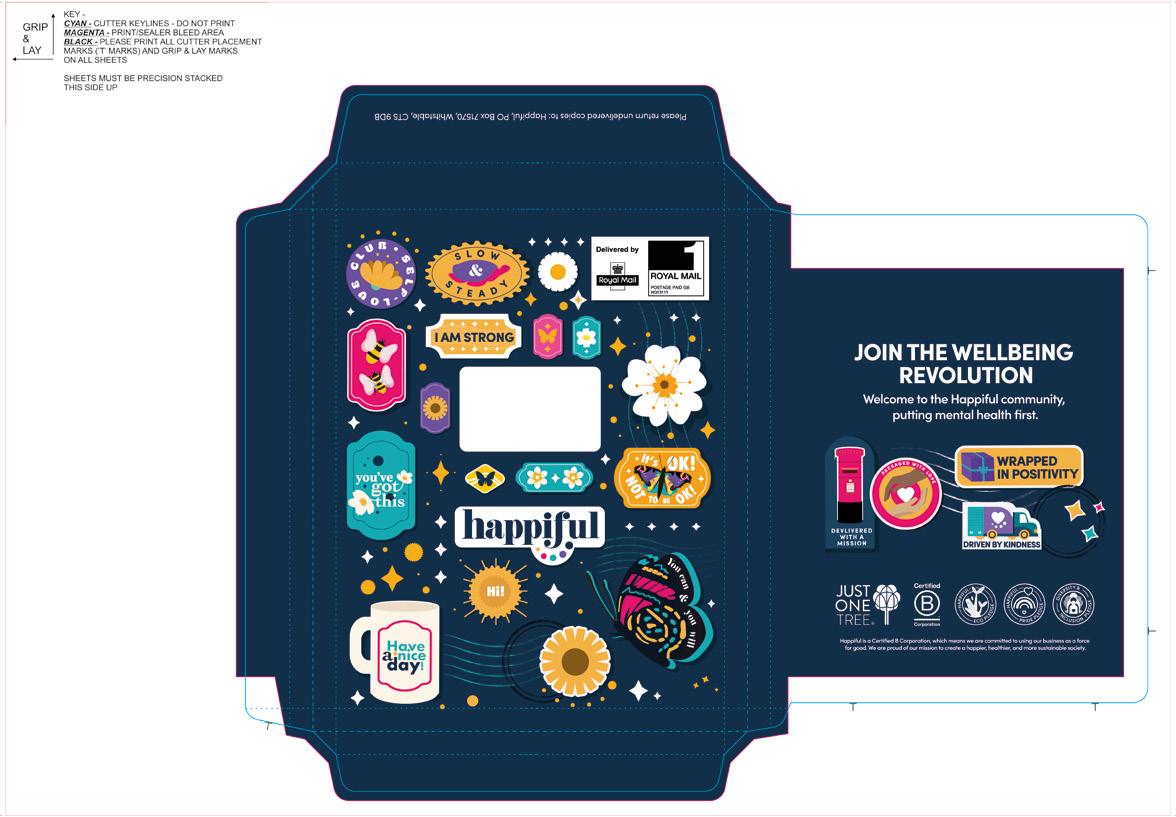




Support the beating heart of your business, by prioritising employees’ mental wellbeing. Purchasing a print subscription to Happiful provides a monthly delivery of positivity straight to their door, packed with expert insight, life-changing hacks, and a wealth of self-help guidance.
• Bigger discounts the more subscriptions your order
• Exclusive 50-page workplace wellbeing PDF
• Content that normalises mental health discussion
• For every tree used to print our magazine, we plant two
• 100% recyclable magazine and envelope
74 | Issue 86 | happiful.com Mind your business Your go-to guide to thriving on the clock
PUT WELLBEING ON THE CORPORATE AGENDA A
of Happiful for staff Visit happiful.com/hub/staff-subscriptions today!
year
Enhanced pattern recognition: Joining the dots
Could the experience of enhanced pattern recognition in people with ADHD and dyslexia be a hidden strength of the conditions?
Writing | Kathryn Wheeler
The human mind is wired to find patterns in the world around us – it’s a baseline survival mechanic that helps us to predict what might be coming. Our brains are so good at this that we still far outperform computerised algorithms and artificial intelligence, and our ability to do so is what makes us distinctly human.
While it’s something that will feel familiar to many, people with ADHD or dyslexia have been found to experience enhanced pattern recognition – a label which describes the ability to find and recognise patterns with only vague or limited information, beyond what most people are capable of. But why is this, what does it look like in practice, and what is the impact?
“The ADHD brain has greater synaptic connections in the part of the brain that deals with visual imagery, therefore
making them ‘visual thinkers’ and enhancing pattern recognition,” explains Dr Tony Lloyd, CEO of the ADHD Foundation. “Like dyslexia, the ADHD brain processes information in different ways. So we can only hypothesise that while ‘most’ ADHD brains have poor working memory, the greater ‘visual thinking’ may be an evolutionary adaptation for poor working memory – or an example of the adaptive, evolutionary diversity of human neurocognitive capabilities that is the ‘universal design’.”
Though highlighted as a relatable experience for ADHD individuals, recent research into the link is fairly limited, and enhanced pattern recognition alone is not enough to fulfil a diagnosis. That said, in community forums and on discussion boards, people with ADHD describe various forms of enhanced pattern recognition, sharing examples such as being
able to predict film and book plots early on, strong word association, and predicting behavioural patterns in others. Danielle Cannon was diagnosed with ADHD, combined type, in 2021 at the age of 22. Although she recalls recommendations for getting tested as far back as primary school, it wasn’t until lockdown – when she saw a lot more discussion around ADHD – that she realised she ticked a lot of boxes, and referred herself to be tested. Enhanced pattern recognition is an experience that feels familiar to her.
“My first experience with pattern recognition was probably when I was a teenager,” Danielle explains. “I’d always be able to notice the small details in the changes in someone’s behaviour, such as a change in mood or appearance indicating a change in life, such as a difficult time at home or a breakup, or I could recognise early on the signs of depression in a >>>
happiful.com | Issue 86 | 75
your space

classmate or, in the opposite direction, I could recognise a change in mood to being happier or more calm indicating a new relationship, a holiday, etc.”
Danielle feels as though enhanced pattern recognition is something that helps her in daily life. She is able to notice the small details that others might miss, which she explains is particularly helpful when meeting new people and making judgements on their character.
“When I was younger and wasn’t aware of my ADHD or any of the symptoms, I used to ignore the heightened sense of awareness, and often ended up in friendships with quite toxic people, believing that I was wrong or trying not to see all the warning signs,” she explains.
“It would also sometimes cause conflict if I would notice a change in someone and point it out, only to be met with hostility. So it took me a while to learn when and where it is appropriate to verbally note things and have conversations – and how to approach them in a more tactical way. I now find myself a very good judge of character
by picking up the small things some people miss, and it enables me to base my friendships on a more peaceful existence, with little conflict.”
Enhanced pattern recognition can be a really helpful skill in many scenarios. At work, it can make you a good problemsolver, and you may find that certain tasks come naturally to you, or that you are able to make accurate predictions based on the data that is available to you. It’s a strength to bring to an environment that can sometimes prevent challenges for neurodiverse people.
A review by the Attention Deficit Disorder Association found that adults with ADHD are nearly 60% more likely to be fired, and 30% more likely to have chronic or ongoing employment challenges.
Additionally, a 2018 study for the Westiminder AchieveAbility Commission found that 52% of neurodivergent people reported having experienced discrimination during an interview or selection process – and, in the case of dyslexia, while discrimination on the
grounds of dyslexia is prohibited as it is covered by the Equality Act 2010, it is not uncommon for people to feel misunderstood, or additional pressure in the workplace.
However, awareness of potential traits, such as enhanced pattern recognition, can help those with conditions such as ADHD and dyslexia play to their strengths. Dr Tony Lloyd also takes it as an opportunity to share his perspective and challenge the idea of a ‘normal’ way of thinking.
“Everyone’s brain is as unique as their fingerprints, and neurotypes such as ADHD, dyslexia, autism, and dyscalculia, have been around for as long as human beings have been,” he explains. “Often, in the context of Western medicine, anyone who did not meet criteria for the majority was considered abnormal versus the majority that was considered ‘normal’.
“The truth, perhaps, from a 21st-century perspective, is that such differences in neurotypes are the universal design and not an ‘abnormality’ or a ‘disorder’
I’d always be able to notice the small details in a change in someone’s behaviour
at all. Such classifications derive from a culture within academia of language that has proven, ultimately, to be discriminating and stigmatising.”
It’s an ability that many people would wish to be better at, so it makes sense to see enhanced pattern recognition making the list of ADHD and dyslexia strengths. And while more research on this link is needed in order to better understand why it may exist, and how precisely it can manifest itself, for those familiar with enhanced pattern recognition, it presents an opportunity to play into those strengths, and offers a moment of celebration against what can often be a challenging experience.
happiful.com | Issue 86 | 77
your space
5 ways travelling solo can liberate you to self-growth
From a woman who has been there and done that, discover how going your own way can be transformative
Writing | Nicki Bannerman
Are you yearning to travel to far-flung places, but others have different priorities? When my kids left home, I turned a negative situation on its head and flipped on the happy switch as I recalibrated into a new version of myself.
The years fly by fast, so I followed my own mantra to ‘embrace life’. Solo travel enabled me to be a ‘digital nomad’ and a ‘FOGY’ (‘fun older gap yearer’).
Women traveling alone is no longer perceived as a lonely pursuit, it is an act of self-love. I found new life-long friends and memories. I saw the Deep South in Elvis’s footsteps, visited friends in Oz, and Asian temples at dusk as dragonflies circled overhead. It was life-changing. Here are five more ways solo travel can lead to self-growth to inspire you to pick up your passport:
1. You will see how brave you truly are
Get your first boost from arriving at your destination single-handedly. Your dopamine will uplift you and, without
distractions, you can read, sleep, or party when and how you want. From seeing your bravery in action, you will grow as a person. Your sense of achievement will uplift your wellbeing and give you a new sense of freedom. Live the life you want, and be your own best friend.
2. Learn to be at one with yourself
Alone, the joys are heightened. With no one to take the focus, the experience becomes mindful. Food tastes better, views are more tranquil, and sleep is more indulgent. Be selfish in a good way!
When stripped of others ‘beholden’ demands, you go with the flow, and the energy and flexibility of how the mood takes you. There is a huge difference between being lonely and being alone. I find exploring new places stimulating and less lonely than being in your own home. Surprise yourself and enjoy the journey.
3. Reap the rewards of company, when you want it
Mix up your itinerary or join tours to meet like-minded souls. Join
groups in places that make you feel slightly less comfortable. Liberate yourself to explore independently where you feel more within your comfort zone. Discover experiences through apps or magazines. I did cooking classes in Rome and New Orleans. There are even walking tours and rooftop cocktail groups for drinks and dinners. To add to the connection, I published daily blogs on social media as I trailed around.
4. Feel empowered by personal safety
Your peace of mind is important when you travel solo, and safety is imperative. But it can lead to gaining a new sense of being able to cope on your own – now you can survive anything, the world is your oyster!
Keep your wits about you avoiding quiet places late at night – I asked a group of girls if I could walk with them in Nashville when my Uber didn’t show. Judge whether valuables are safer on you or left in your accommodation – I took spare everything, including travel
78 | Issue 86 | happiful.com
I discovered how to be truly present and enjoy the little things there in the moment

cards (which I needed when the bank machine swallowed mine in Vietnam) and even a packed a spare phone.
Remember to be as safe as you want to be, and always ask for help if concerned. I was searched for guns in Memphis on Halloween, and chased by a rabid monkey in Cambodia.
When you look back, you will be proud of how you survived the experiences. Even the setbacks will fill you with pride.
5. Discover how to accept your emotions as part of your journey
On days I felt alone, I sat and compiled playlists. Music or
radio is a huge comfort when you need company. I took myself for a walk to see beautiful views in Dubrovnik, tried sumptuous food in Italy, visited art and vineyards, and found huge moments of joy. Treating yourself to what makes you happy can help with those low moods.
But also try to have fewer expectations around constant happiness. I discovered how to be truly present and enjoy the little things there in the moment. Not every day or minute will be perfect – it wouldn’t be at home either, but the highs will be higher! Enjoy the journey to selfgrowth for your mental health and wellbeing, and the evolved new version of yourself.
happiful.com | Issue 86 | 79

In schools, workplaces, in classes, and at home, meditation and mindfulness are on the rise. Often heralded as a supportive solution to stress, anxiety, depression, and even physical pain, meditation has a lot to live up to – but more and more people are beginning to attest to its effectiveness.
The science
According to a US survey shared by the National Center for Complementary and Integrative Health, the number of adults who practise some form of meditation tripled between 2012 and 2017, from 4.1% of the population to 14.2%. So, what’s got so many people interested in meditation?

In one study, published in The Journal of Alternative and Complementary Medicine, which looked at nearly 1,300 adults, meditation was proven to be linked to a reduction in anxiety, with the effect being strongest in those who presented with the highest levels of anxiety. Another study, shared in the Journal of Occupational Health Psychology, also found a similar effect in employees who used a mindfulness meditation app for eight weeks – they went on to experience a decrease in job strain and distress, as well as improved overall wellbeing. But decreasing stress and anxiety is just one factor. Research published in Frontiers in Human Neuroscience found that participants who listened to a meditation tape experienced improved attention, and a metaanalysis of 22 studies, published in the Journal of Consulting and Clinical Psychology, found that meditation has an ability to increase our compassion towards ourselves and others.
Setting your intention
Tempted to give it a go yourself? Starting out with meditation can feel intimidating, but it doesn’t have to be.
“Short, daily meditation can change our relationship to thoughts. This, in turn, reduces the overthinking that causes so much of our stress, leading to more clarity, focus, and calm,” explains Frances Trussell, hypnotherapist and mindfulness meditation
teacher. “Becoming a meditator transformed my own life; before meditation, I’d had terrible anxiety and depression for as long as I could remember. That’s why I went on to become a teacher, and over the last decade, I’ve seen it improve the lives of thousands of people.
“Just like with physical exercise, we get far better results by doing a little consistently than a whole heap once in a while. However brief your meditation, by showing up daily you are setting a clear intention that you prioritise being present in your life, and taking care of your mental health.”
Meditation has an ability to increase our compassion towards ourselves and others
Giving it a go
To get a taste of what meditation has to offer, I set an intention for the week: 10 minutes of daily guided meditation each morning. Here’s what I learned...
• The position doesn’t matter. Like me, you might have been under the impression that to meditate you had to sit crossedlegged on the floor, with a straight back and your hands resting on your knees. While I started out like this, by the third day I transitioned to lying down on my yoga mat. I was
more comfortable this way, and better able to fully relax.
• Not every guided meditation will be right for you. To find a recording, I turned to Spotify. At the start of the week, I shuffled through a couple of options, before landing on the ‘10-Minute Guided Meditation’ from Headspaces’ Meditation
Made Simple collection. I was drawn to recordings that were warm and supportive, and less so to ones that felt overly formal. What works for you may be different, and figuring that out will help you find your match.
• Small acts of self-care go a long way. If 10 minutes seems like a really short amount of time, it’s because it is. But what I found was that, even in such a small amount of time, I felt the effects. It was easy to slot in, and taking that time each morning to slow down, to connect with my thoughts and feelings, put me in a productive head space at the start of the day, and quickly became something I felt grateful for.
• It gets easier. Even though I’m a regular at my local yoga studio, where meditation can sometimes come into practice, I did find the idea of meditation alone a little intimidating. But by allowing myself the freedom to explore it in a way that suits me (picking the position I was in, the recording I used, the length, and the time I did it) I found it easier to sink into each day – and it’s a habit I hope to keep. >>>


Over to you
The first thing to consider when starting out with short, daily meditations is what you want from it. Is it relaxation? Or to improve self-compassion or confidence? Is it for sleep or healthy habits? Once you’ve figured that out, you can decide whether you want to find a guided meditation (in which case, searching on YouTube or Spotify for meditation on the theme you are interested in will bring up plenty of results). Or you may want to go your own way, and prefer to set a timer and focus only on your breathing.
Like me, start with just short sessions – 10 or even five minutes is a great place to begin. You can set a goal of how often you want to meditate, be it daily or a couple
of times a week. Once you’re in the swing of things, you may wish to meditate for longer, or you may not – it’s your call. Get comfortable, in whatever way that is for you – you can even do your meditation on the move (go for a walk and sync your breath to the steps you’re taking) if that’s what suits you.
“Meditation can be intimidating when you first begin; we can have so many doubts around whether we are doing it ‘right’, and preconceptions about how it is supposed to feel,” Frances says. “If there’s one thing for sure, it’s that your mind will likely be busy and you’ll get distracted –this is just what the mind does. Don’t get put off by this, or get cross with yourself. It’s our
Frances Trussell is an author, therapist and mindfulness meditation teacher. Find out more on the Hypnotherapy Directory
job in meditation to simply pay attention to what is happening, without judging it, gently bringing the mind back to the object of the meditation (usually our breath or the body) when we notice we’ve got on a train of thought.”
Frances described each time we meditate as being like doing a rep at the gym, as we strengthen the neural pathways that bring our attention back to the present. “Ultimately, we don’t meditate to be good at meditation,” says Frances. “We meditate to get better at showing up for our lives – meditation is just the way we practise this.”
So, with a compelling list of evidenced benefits, and an entry point that’s accessible to all, the only question left is, why not?
82 | Issue 86 | happiful.com
Where to find help
Looking for support with your mental health?
Here are some places that can help:
CRISIS SUPPORT
If you are in crisis and are concerned for your own safety, call 999 or go to A&E
Call Samaritans on 116 123 or email them at jo@samaritans.org
GENERAL LISTENING LINES
SANEline
SANEline offers support and information from 4pm–10pm: 0300 304 7000
Mind
Mind offers advice Mon–Fri 9am–6pm, except bank holidays: 0300 123 3393. Or email: info@mind.org.uk
Switchboard
Switchboard is a line for LGBT+ support. Open from 10am–10pm: 0300 330 0630. You can email: chris@switchboard.lgbt
p25
LGBTQ+ COMMUNITY AND SUPPORT
To find out more about LGBTQ+ life, connect with a community, and find support, visit stonewall.org.uk

Why not…
• Pass me on to a friend who might appreciate some articles.
• Get crafty and use me for a vision board or collage.
• Keep me on a coffee table to pick up when you need a boost
• Remember I’m 100% recyclable, so pop me in your recycling bin.


p43
p61
BIPOLAR INFORMATION
For support and information about bipolar disorder, head to www.bipolaruk.org
CONNECT WITH A LIFE COACH
Learn more about life coaching and reach out to a professional using lifecoach-directory.org.uk
Our two-for-one tree commitment is made of two parts. Firstly, we source all our paper from FSC® certified sources. The FSC® label guarantees that the trees harvested are replaced, or allowed to regenerate naturally. Secondly, we will ensure an additional tree is planted for each one used, by making a suitable donation to a forestry charity. Happiful is a brand of Memiah Limited. The opinions, views and values expressed in Happiful are those of the authors of that content and do not necessarily represent our opinions, views or values. Nothing in the magazine constitutes advice on which you should rely. It is provided for general information purposes only. We work hard to achieve the highest possible editorial standards, however if you would like to pass on your feedback or have a complaint about Happiful, please email us at feedback@happiful.com. We do not accept liability for products and/or services offered by third parties. Memiah Limited is a private company limited by shares and registered in England and Wales with company number 05489185 and VAT number GB 920805837. Our registered office address is Building B, Riverside Way, Camberley, Surrey, GU15 3YL.
Head to happiful.com for more services and support
Cover illustration | Rosan Magar
DEVOTED TO MENTAL HEALTH & WELLBEING + ISSUE 86 £5.99 ALL WORK NO PLAY? Burnt toast theory Couldlife’sli leinconveniences bepartofabiggerplan? Why we all need a third place SPOTLIGHT Howtheworldofsport issteppinguptotackle theclimatecrisis A LEAGUE OF THEIR OWN Romantic revelations from your favourite reality TV A love-hate relationship Step out of the shadows A little self-trust is all it takes to let yourself shine Finished with your magazine?
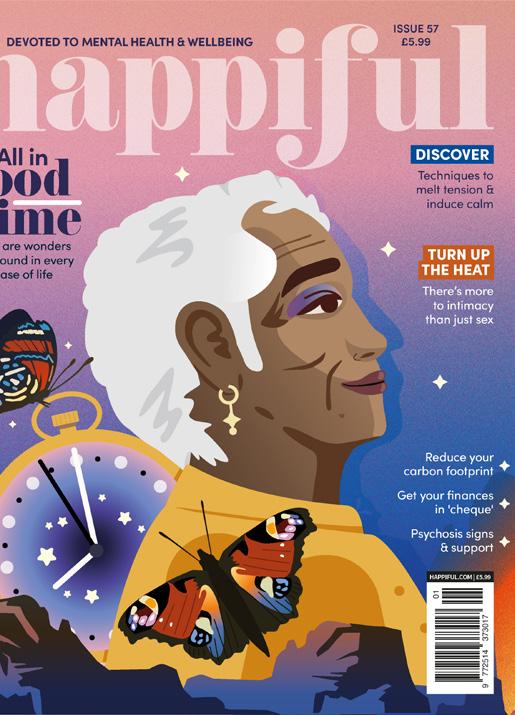
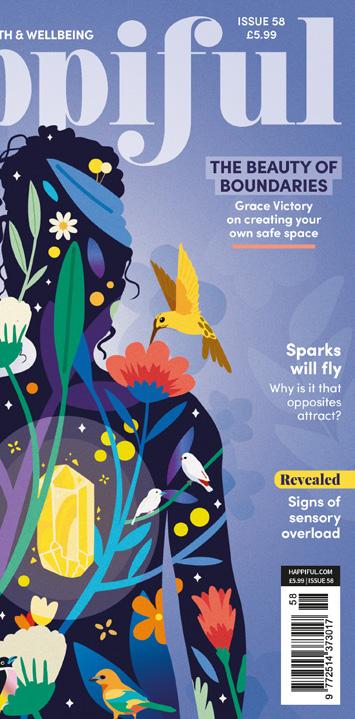






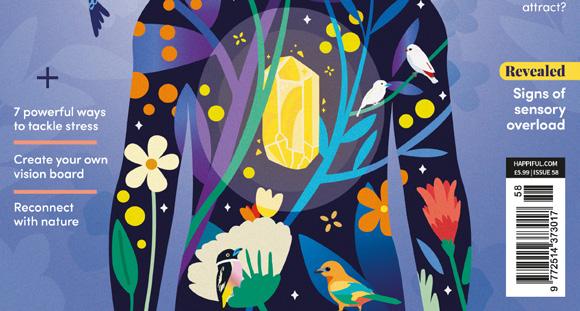









Exclusive journaling section Includes UK delivery Cancel at any time only £5.99 per month Delivering on our mission to create a happier, healthier, and more sustainable society.

























































































































